MARIANI’S
Virtual
Gourmet
April 2,
2017
NEWSLETTER
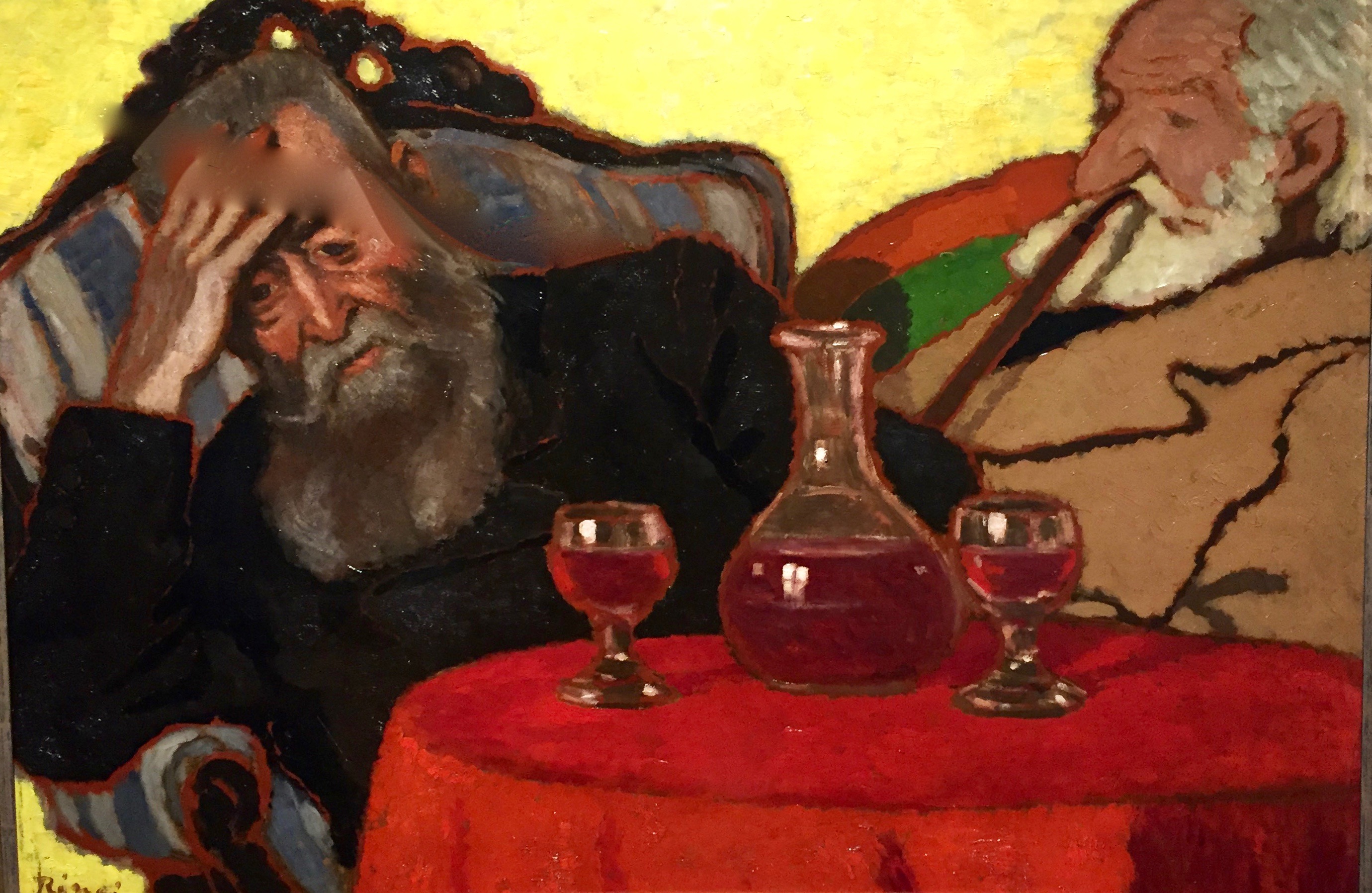
"My
Father and Uncle Piacsek Drinking Red Wine" (1907) by
József Rippl-Rónai
IN THIS ISSUE
BUDAPEST'S BEST NEW HOTELS
AND RESTAURANTS
By John Mariani
NEW YORK CORNER
DELMONICO'S
By John Mariani
NOTES FROM THE WINE CELLAR
THE WINES OF ROME, Part Two
By John A. Curtas
❖❖❖
BUDAPEST'S BEST NEW HOTELS
AND RESTAURANTS
Part One
By
John Mariani
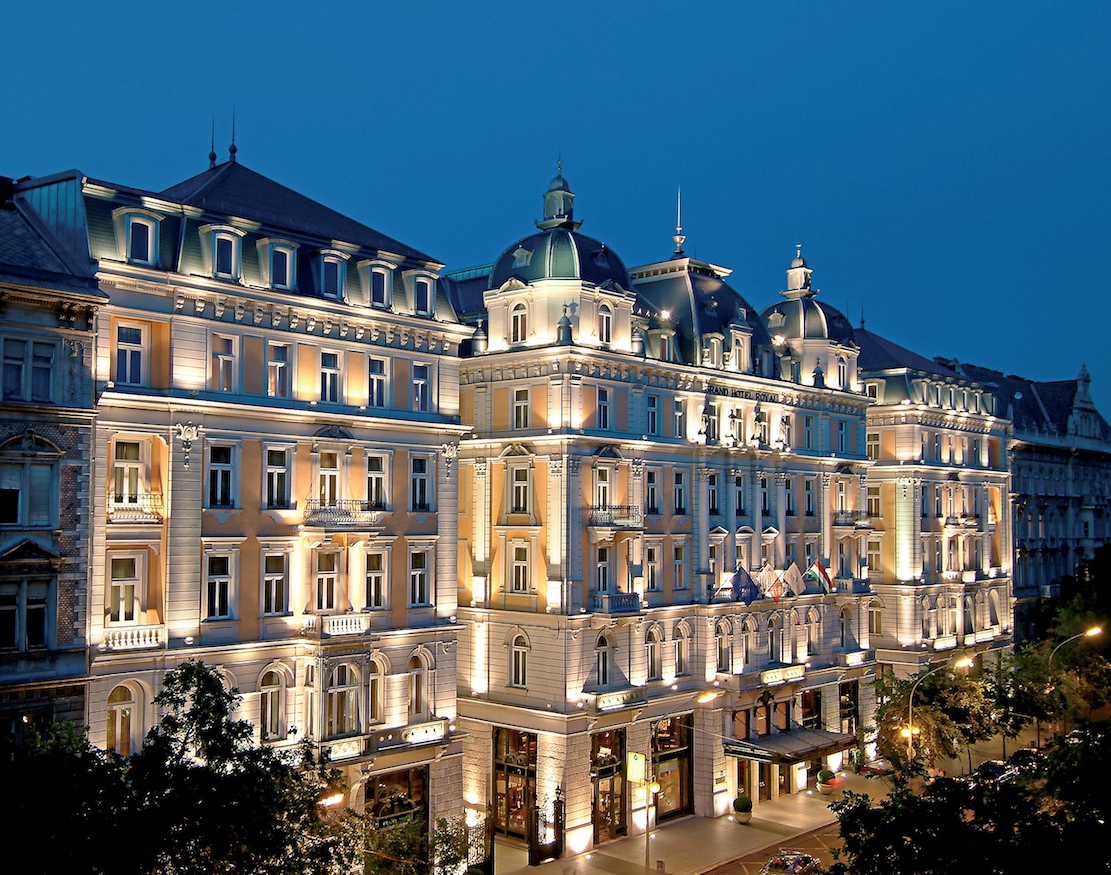
CORINTHIA HOTEL BUDAPEST
As Carolyn Bánfalvi’s
comprehensive, though now
thoroughly out of date, Food Wine
Budapest (2007) notes, “Our
biggest disadvantage is that all of our traditions
disappeared during the forty
years of communism. And worse, we don’t have
anyone to ask about our past
traditions. We didn’t just have to start from the
beginning in 1989, but from
below the beginning.”
In just one decade since that book’s
publication, everything has changed.
Not only have the traditions been revived
but Budapest’s chefs now have
the money and ingredients to produce food as
good as any in Eastern Europe, not
least in the new deluxe hotels, which have
poured as many resources into their
restaurants as into their rooms and amenities.
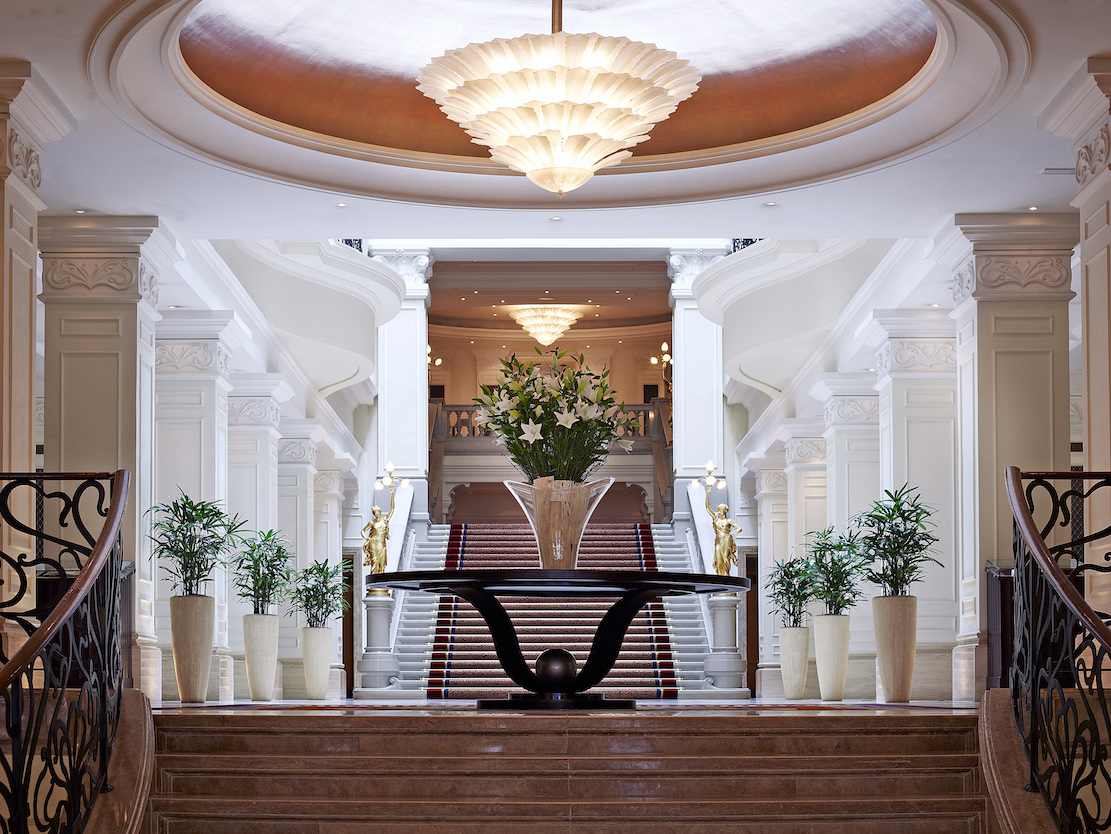 CORINTHIA
HOTEL
BUDAPEST
CORINTHIA
HOTEL
BUDAPEST
Erzsébet
Körut
43-39
36 1 479
4000
If any hotel in Europe
deserves to called
Grand, the new Corinthia certainly does, having been
hewn from an edifice that
debuted in 1896 as the Grand Hotel Royal, which
included innovations like a spa and indoor
heated pool now restored to its blue-tiled luster. Today there is also a sauna, steam
bath, and fitness room, a
business center, complimentary WiFi and non-allergic
pillows are available. And
the multi-lingual service staff has the kind of
Mitteleuropean savoir-faire one would like to think
is
a long Hungarian tradition but which barely existed
ten years ago in this town.
To experience just what the hotel was like in
its heyday—before World W II, serving
as an officers’ quarters till 1953 and during the
more
restricted post-war Soviet control—inquire about a
tour held every Tuesday and
Thursday morning by the unflappable  Tibor
Meskál, senior duty manager, who has
kept files, photos and mementos of his days working
there since the
1960s. I
hesitate to call him
jolly, which makes him sound frivolous, but his
palpable excitement is
infectious in showing
guests all the glories of other times and how they
have been improved upon
since the hotel's re-opening in 2004, now with 439
rooms, 31 suites and 26 apartments.
Tibor
Meskál, senior duty manager, who has
kept files, photos and mementos of his days working
there since the
1960s. I
hesitate to call him
jolly, which makes him sound frivolous, but his
palpable excitement is
infectious in showing
guests all the glories of other times and how they
have been improved upon
since the hotel's re-opening in 2004, now with 439
rooms, 31 suites and 26 apartments.
There is no question you can ask that he does
not have a fascinating answer for, including
anecdotes like the Lumičre
Brothers’ first screening of a motion picture in the
vast Royal Ballroom, later
converted to a cinema. Meskál can personally identify
every photo on the exhibition wall, compiled by the
Hungarian
Museum of Trade—with enormous help from Meskál
himself. If
you recall Frank Morgan’s portrayal
of storeowner Hugo Matuschek at his happier moments
in the wonderful film The Shop Around
the Corner, you’ll have
a good sense of Meskál’s spirit.
He is a treasure.
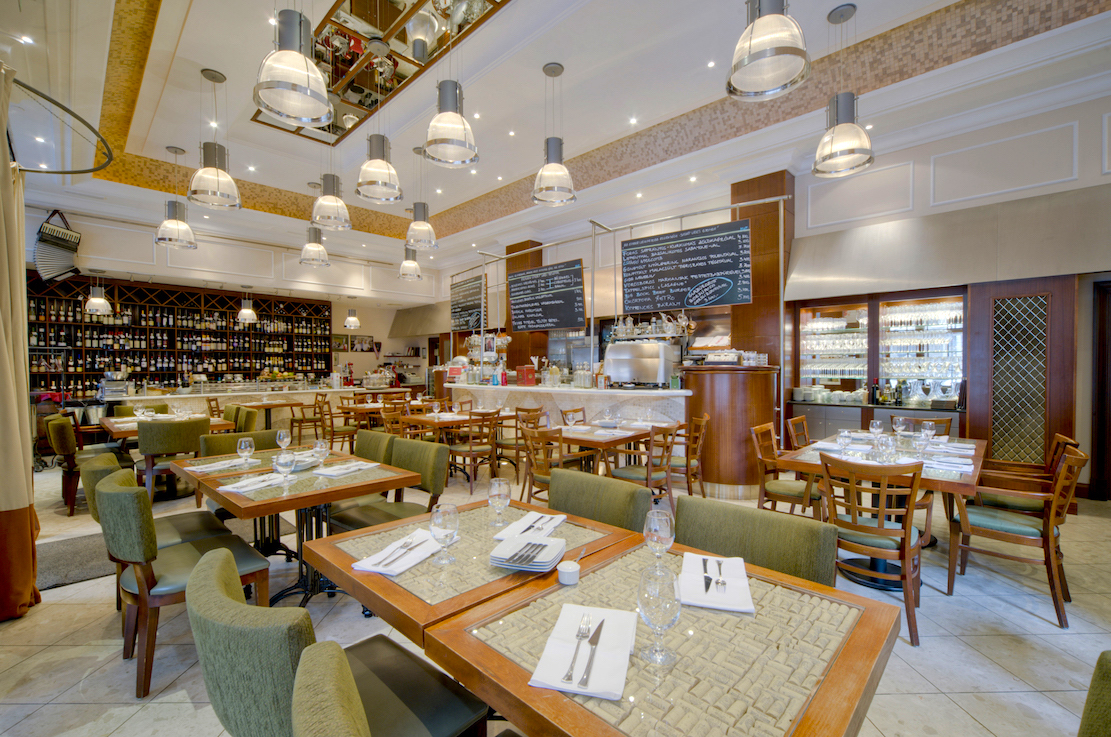 There
are three restaurants at the Corinthian,
one casual, serving traditional Hungarian fare,
another set within the
magnificent atrium, serving a more global menu, and
a third Rockshaw Asian restaurant I did not have a
chance to try.
There
are three restaurants at the Corinthian,
one casual, serving traditional Hungarian fare,
another set within the
magnificent atrium, serving a more global menu, and
a third Rockshaw Asian restaurant I did not have a
chance to try.
Bock Biztró
(left) is a
good-looking, very airy and
bright restaurant overlooking the street, with a
tiled counter and floors,
blackboard menu, hanging lamps and table mats. The
fare is very homey,
modern-day versions of dishes like goose liver
terrine cuddled in its own
yellow fat (1700 Hungarian Forints; 284 HUF=$1),
goosemeat soup with semolina
noodles (1100HUF), excellent veal paprikash with
cottage cheese pasta (3700HUF), and perfectly fried
Wiener schnitzel (3700HUF), sided with butter-laced
potatoes. For
dessert have the
chocolate-sour cherry sponge cake (1100HUF) or the
quaintly old-fashioned
poppy seed noodles with plum (1100HUF).
There is a very complete wine list of the
best bottles coming out of
Hungary and Eastern Europe these days. 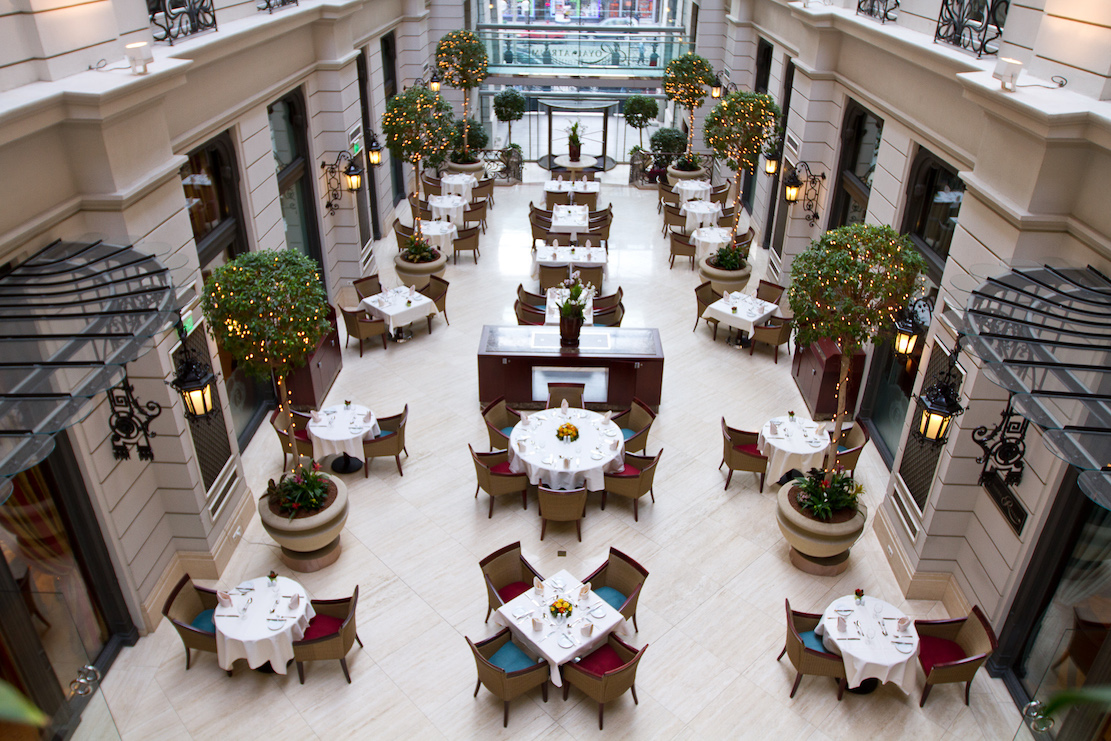
The
Brasserie and Atrium (right) is a
stunning long,
six-story open space whose use at breakfast, when it
is bright and sunny, and at dinner, when
it becomes romantic by candlelight, give it a dual
character that is never less
than casually chic.
The menu,
under Chef Balázs Ölvedy, is international in scope
but grounded in the best available Hungarian
products.
We began with an unexpected smoked
trout sushi roll (3400HUF), and an imaginative
dish of beets, wasabi and rye crisps with thin
chocolate slices and
sweet citrus (3200HUF), followed by generously
portioned main course of lamb
chops prettily presented on a small wooden desk
(10,000HUF). Pike
perch, a fish that can use added
flavors, was well served here with ratatouille,
potato foam and garlic ash
(3900HUF). My
favorite dessert
was a luscious milk chocolate caramel slice with
salted hazelnuts and rich
chocolate sauce (1800HUF ).
As at Bock Biztró, the wine list at the
Brasserie is one of the best in the country. A 12 percent service charge is
added to the bill, so no need
to tip.
Bock Biztró is open for
lunch and dinner Mon.-Sat.; Atrium is open for
breakfast and dinner daily.
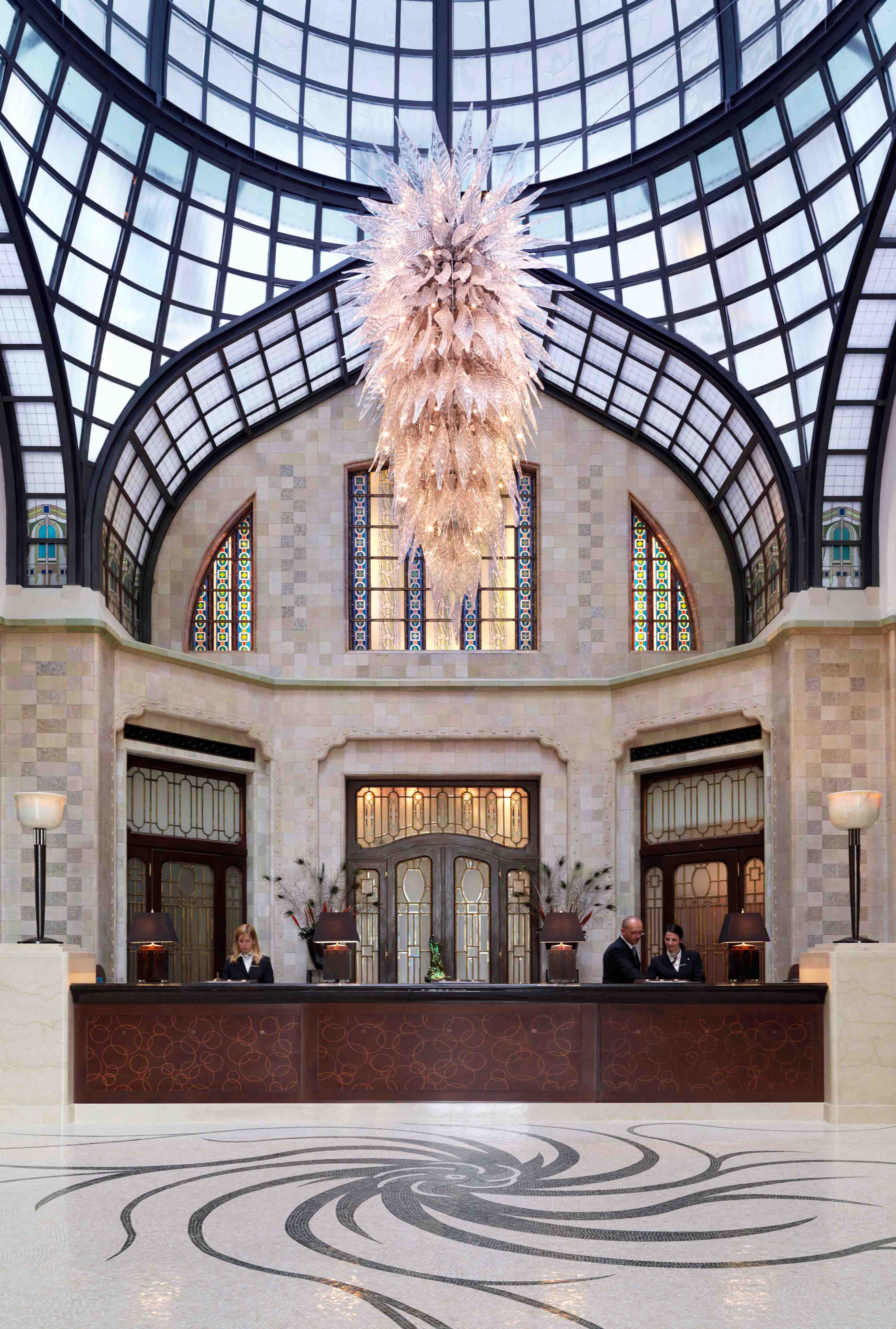 FOUR
SEASONS GRESHAM PALACE HOTEL
FOUR
SEASONS GRESHAM PALACE HOTEL
Széchenyi
István tér 5
36-1-268-6000
Nowhere is the new sophistication of
Budapest
more evident than in the Four Seasons Hotel,
occupying what was formerly the
magnificent art nouveau Gresham Palace, which long
ago lost its 1907 Secessionist-Art Nouveau
magnificence. Now cleaned and
restored, it is more beautiful than ever.
The building seems to anchor the Chain Link
Bridge on the Pest side of the Danube, and its grand
arcade entrance hall (left) evokes all
the awe it once induced when it was the Gresham
insurance company's flagship, from its glass dome
and crystal chandelier to its
impressive front desk and the hallway leading from
it, called the Peacock
Passage.
You will be greeted with
the same graciousness you’d expect at a deluxe hotel
in London, Paris or 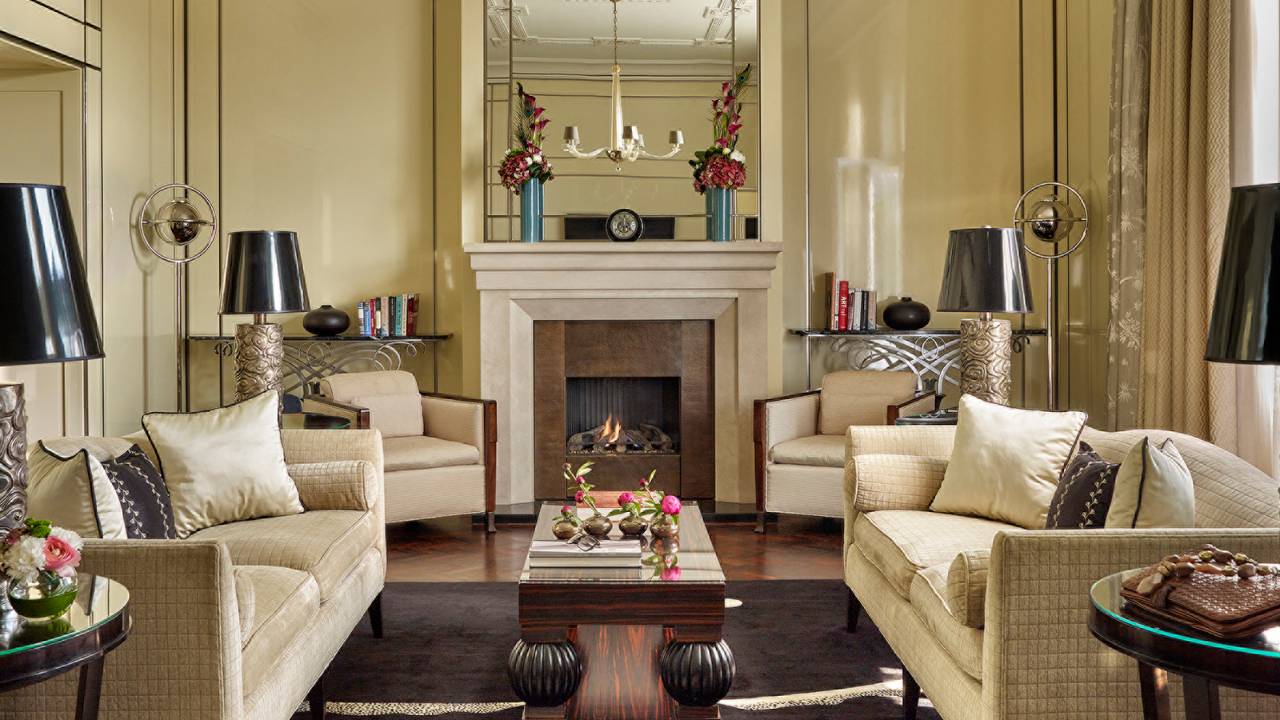 Rome,
and the 179 rooms—a modest number, for maximum
effect—overlook either the river
or the Old Town.
USA
Today and the NY Times Digest are available, free
Wi-Fi works perfectly, and it’s
the kind of place where, alerted I was checking out
at 8 a.m., they had already
brought my car around without having to request it.
Rome,
and the 179 rooms—a modest number, for maximum
effect—overlook either the river
or the Old Town.
USA
Today and the NY Times Digest are available, free
Wi-Fi works perfectly, and it’s
the kind of place where, alerted I was checking out
at 8 a.m., they had already
brought my car around without having to request it.
The rooms’ interiors are sumptuous but
restrained, done in soft tones of gray, white, taupe
and lavender, with fresh
flowers set about and large windows to let in the
sunlight. Bathrooms are
spacious and well lighted. The Health Club takes up
the entire top floor, with
state-of-the-art facilities.
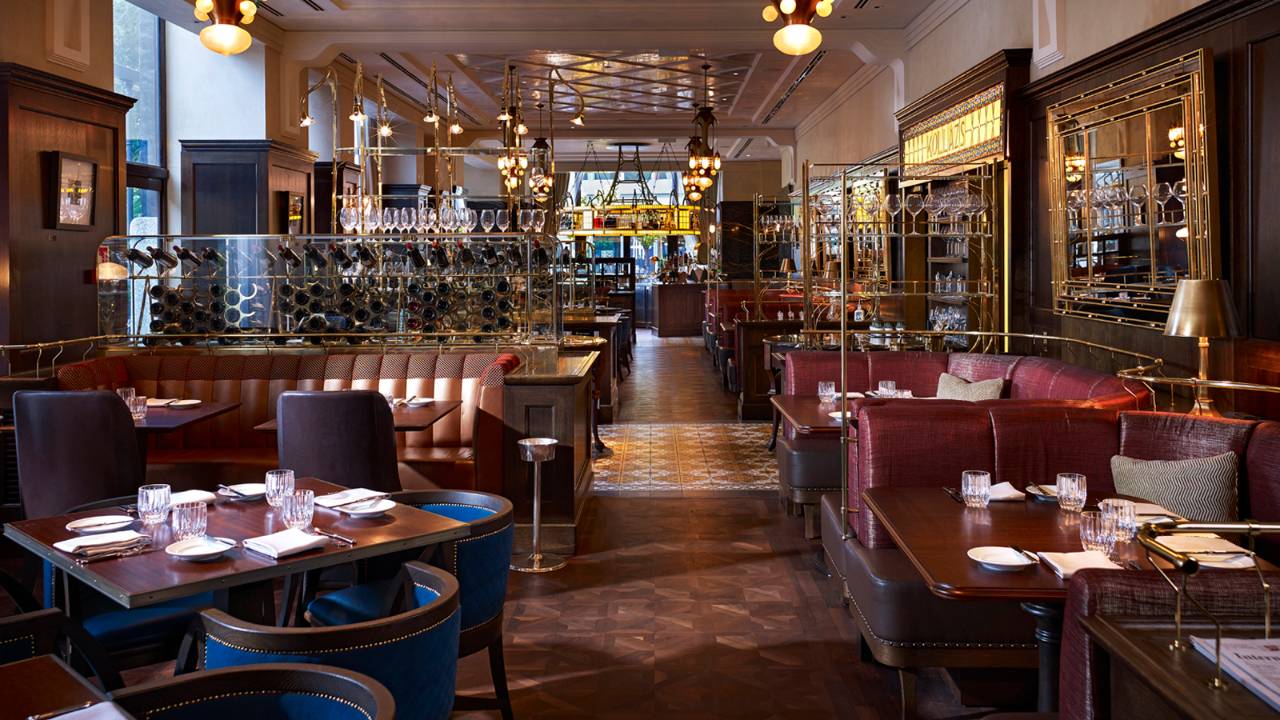 The restaurant here is
named Kollázs—“collage,”
referring
to the marriage of old and new interpretations of
European brasserie
fare by young chef Árpád Györffy. The lay-out could
not be more convivial, retaining a sense of Old
Budapest comfort while offering excellent service
and beautiful presentations,
which include a bountiful bread counter to the rear
and a smart bar-lounge at the
entrance. Lighting
and noise
levels are perfect for breakfast, lunch or dinner. (There is also afternoon tea
served in the adjacent lobby
lounge.)
The restaurant here is
named Kollázs—“collage,”
referring
to the marriage of old and new interpretations of
European brasserie
fare by young chef Árpád Györffy. The lay-out could
not be more convivial, retaining a sense of Old
Budapest comfort while offering excellent service
and beautiful presentations,
which include a bountiful bread counter to the rear
and a smart bar-lounge at the
entrance. Lighting
and noise
levels are perfect for breakfast, lunch or dinner. (There is also afternoon tea
served in the adjacent lobby
lounge.)
The plates, made of various ceramics, are
decorated just enough without being fussy,
beginning with a tantalizing chicken liver ice cream
as an amuse.
Goat’s cheese and beets come with
pear and dried cherry (3300HUF). A
succulent rack of rosy Hungarian lamb comes
with mushrooms, a variety of charred sweet onions
and seasoned with a whiff of
rosemary (5800HUF). Particularly
delicious was a fat lamb
shank cassoulet (4500HUF).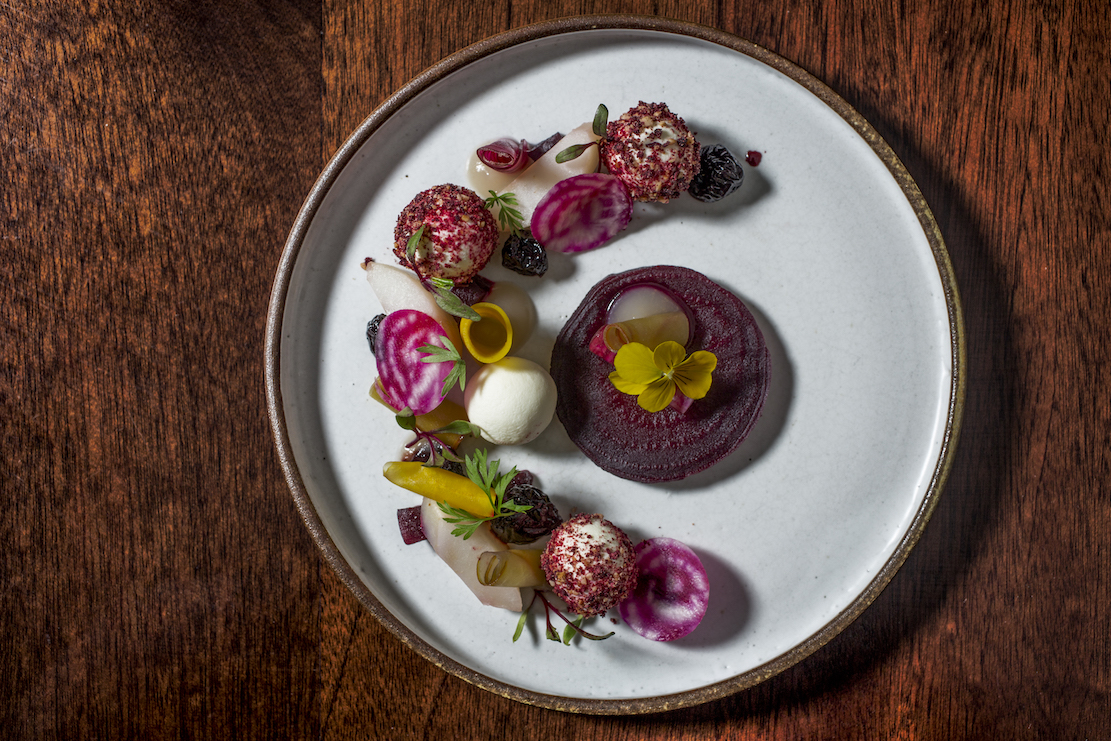 These
were followed by a
warm chocolate cake with crčme fraîche (1900HUF) and
buttery French toast with strawberry
ice cream (1900HUF).
These
were followed by a
warm chocolate cake with crčme fraîche (1900HUF) and
buttery French toast with strawberry
ice cream (1900HUF).
There is also a "Blind
Date" menu (19,000HUF; 29,000 with wines) we enjoyed
that included
marinated trout with apple and smoked foam; porcini-packed agnolotti with
leek sauce; braised veal leg with green bean and
tomato; a wagyu trilogy and rye bread ice cream with
pine bud and dates .
The eight-page wine list has been
selected by head sommelier Matyas Szik to
emphasize the finest local wines--and there are
plenty of them--along with European, U.S. and South
American bottlings and 15 Champagnes. The selection
of Hungarian dessert wines includes a rare Szepsy 6
puttonyos aszú 2008 (59,000HUF).
Kolláczs
is open for breakfast, lunch
and dinner. Sunday brunch.
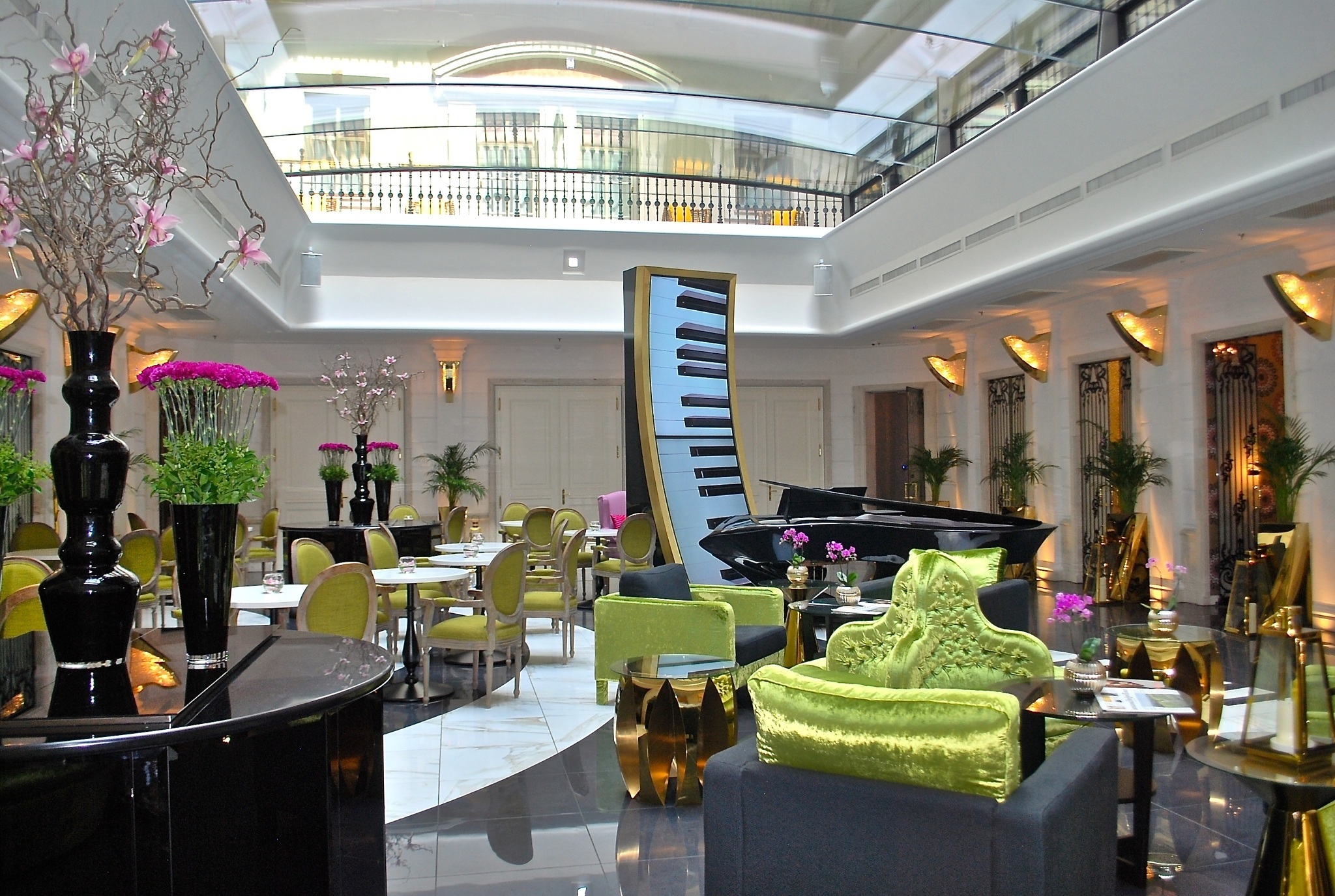 ARIA
HOTEL
ARIA
HOTEL
Hercegprimás
utca 5
36-1-445-4055
Aria is a very different kind of
hotel from The
Four Seasons or Corinthia. Indeed, it would be
unique anywhere, created as it
is around music and harmony, which begins in the
large lobby (the building had
been a somber bank) with a fanciful grand piano
designed by Gergelt Bogányi, lime
green satin sofas and all sorts of musical motifs. Breakfast, tea and cocktails
are served here, an ideal spot after a night at the
Budapest Opera.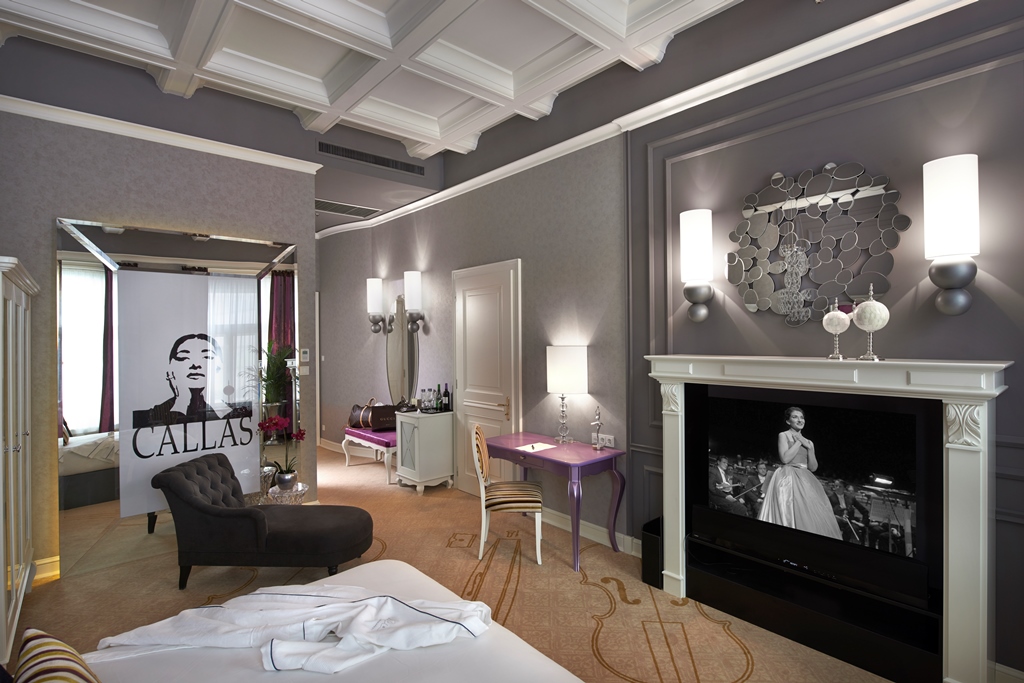
The guest rooms curve around this central lobby
in a series of elegant, skylighted terraces, with
tracings and cartoons of jazz and musicians. Each of
the 49
rooms is dedicated to a different composer, with
different tonal colors and
furniture to evoke the master’s style.
Their music, as you might expect, is always
available on request.
The restaurant here is called, not
surprisingly, Stradivari (below), after the Italian master
violin maker, and echoes
Budapest’s legendary Gerbeaud Café, established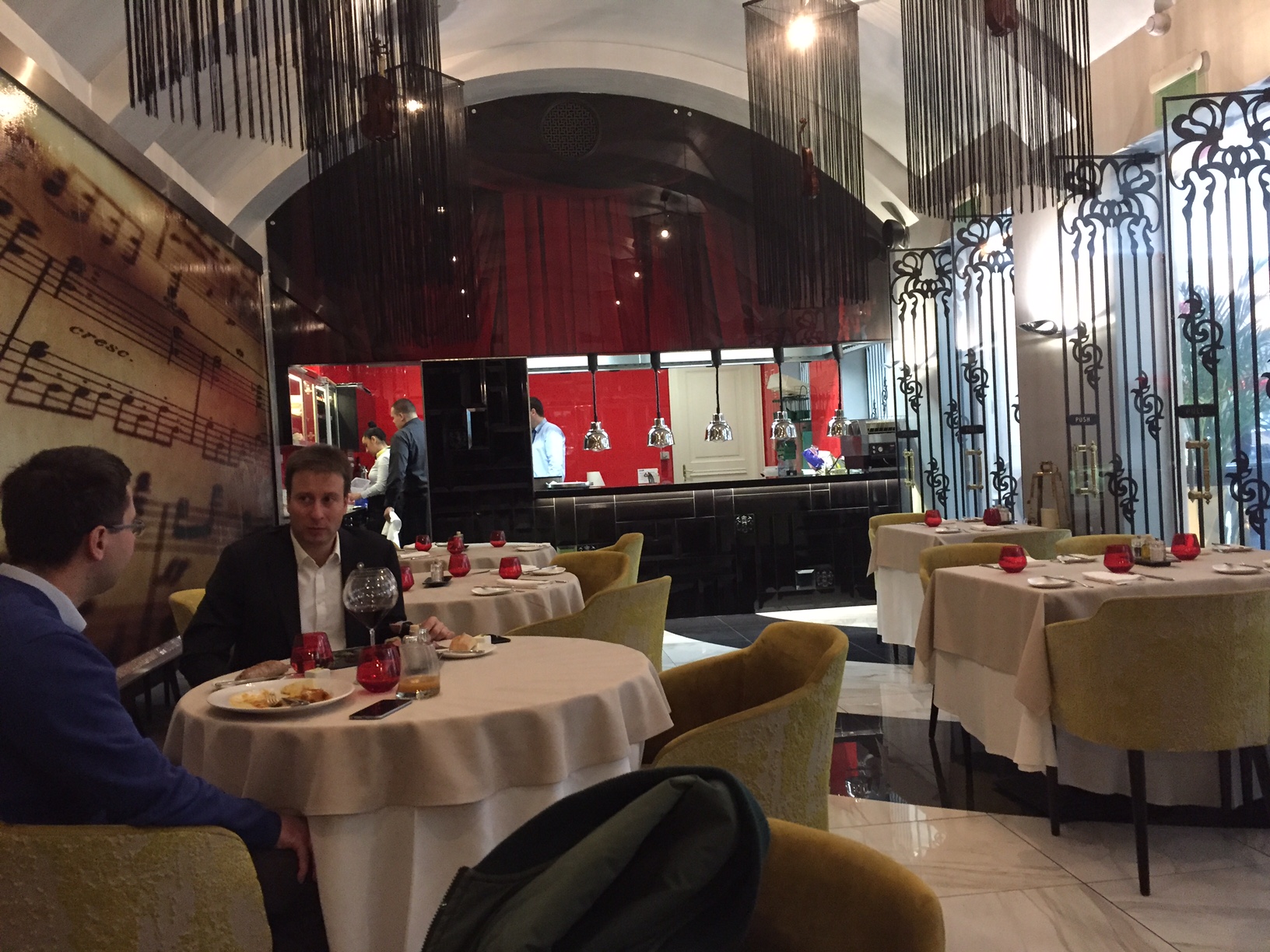 in 1858, via the
Gerbeaud
family still being in charge at the new restaurant.
in 1858, via the
Gerbeaud
family still being in charge at the new restaurant.
Ultra-modern as it
is, Aria there
is not a whiff of the
antique here. Violins hang from the ceiling and
water washes over a wall of sheet
music. The food presentations, by Chef Ferencz
Gábor, are equally lovely and contemporary,
beginning with pumpkin
cappuccino with pumpkin seed doughnut, ricotta and
the sweet red peppers called kapia (1700
HUF). We enjoyed a crispy
millefeuille crȇpe of wonderfully spiced chicken Hortobágyi paprikash (2,690HUF).
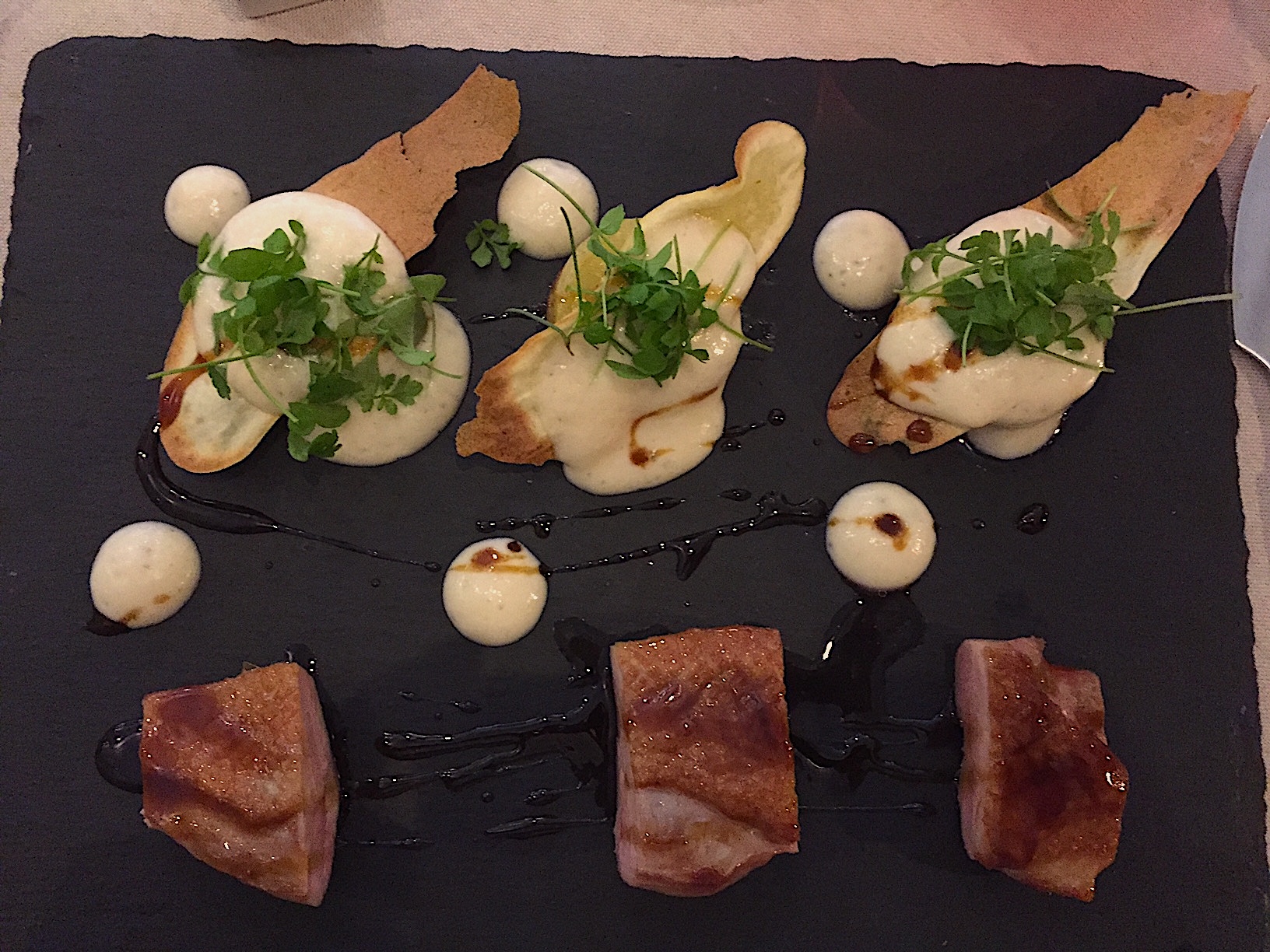 Crispy duck
breast came with cauliflower mousse on potato tuiles
and steamed yellow beets (4,490HUF) was served on a
slab of thin slate (right). Hearty and bracing in cold weather was a
traditional Hungarian paprika-potato stew with
pork medallions (4,490HUF), and for
something quite different, try the Mangalica
poached pork belly, fried ears, smoked ham pickles
and a sauce gribiche (2800
HUF). The
desserts are
well-attuned to modern pastry-making, as in the
salted caramel with popcorn,
bacon and banana (1990 HUF).
Crispy duck
breast came with cauliflower mousse on potato tuiles
and steamed yellow beets (4,490HUF) was served on a
slab of thin slate (right). Hearty and bracing in cold weather was a
traditional Hungarian paprika-potato stew with
pork medallions (4,490HUF), and for
something quite different, try the Mangalica
poached pork belly, fried ears, smoked ham pickles
and a sauce gribiche (2800
HUF). The
desserts are
well-attuned to modern pastry-making, as in the
salted caramel with popcorn,
bacon and banana (1990 HUF).
There is a five-course tasting
menu at 16,990HUF.
Stradivari
is open every day for breakfast,
lunch, wine and cheese, and dinner.
By John Mariani
56 Beaver Street
212-509-1144
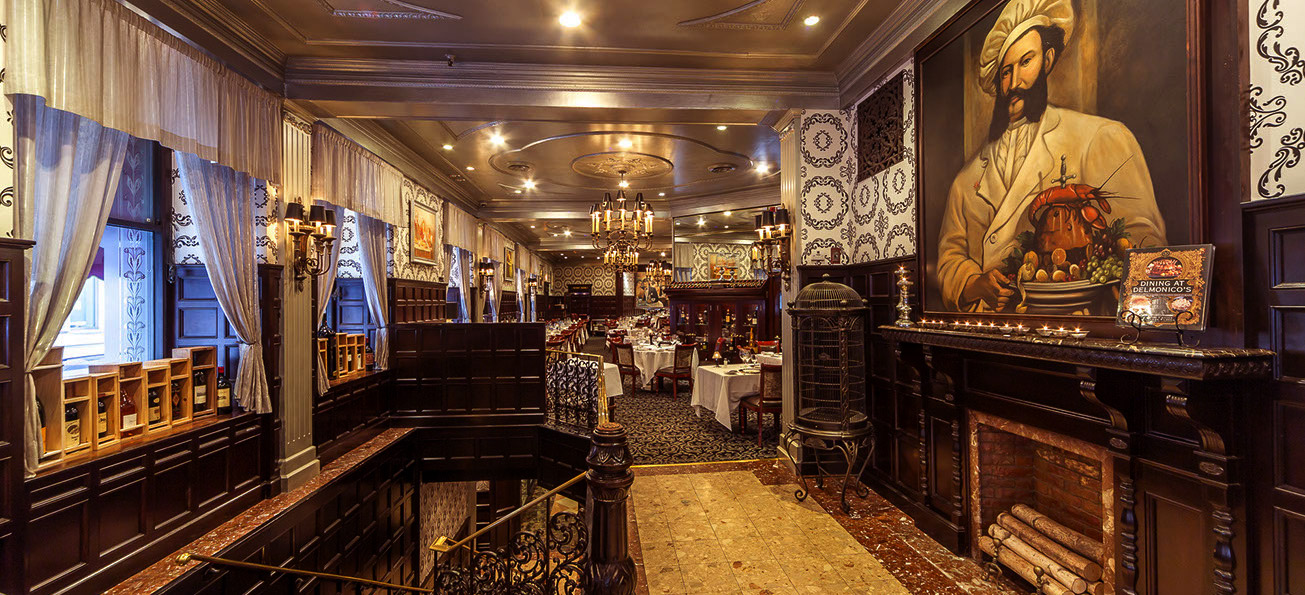
Try
to imagine a time when NYC had no
restaurants, only eating houses and
taverns.
Then time travel back to
1827, when John and Peter Delmonico, two
Swiss brothers, the first a former sea
captain, the second a pastry-shop manager,
opened up a small, six-table
coffee-and-pastry shop called Delmonico’s on
William Street.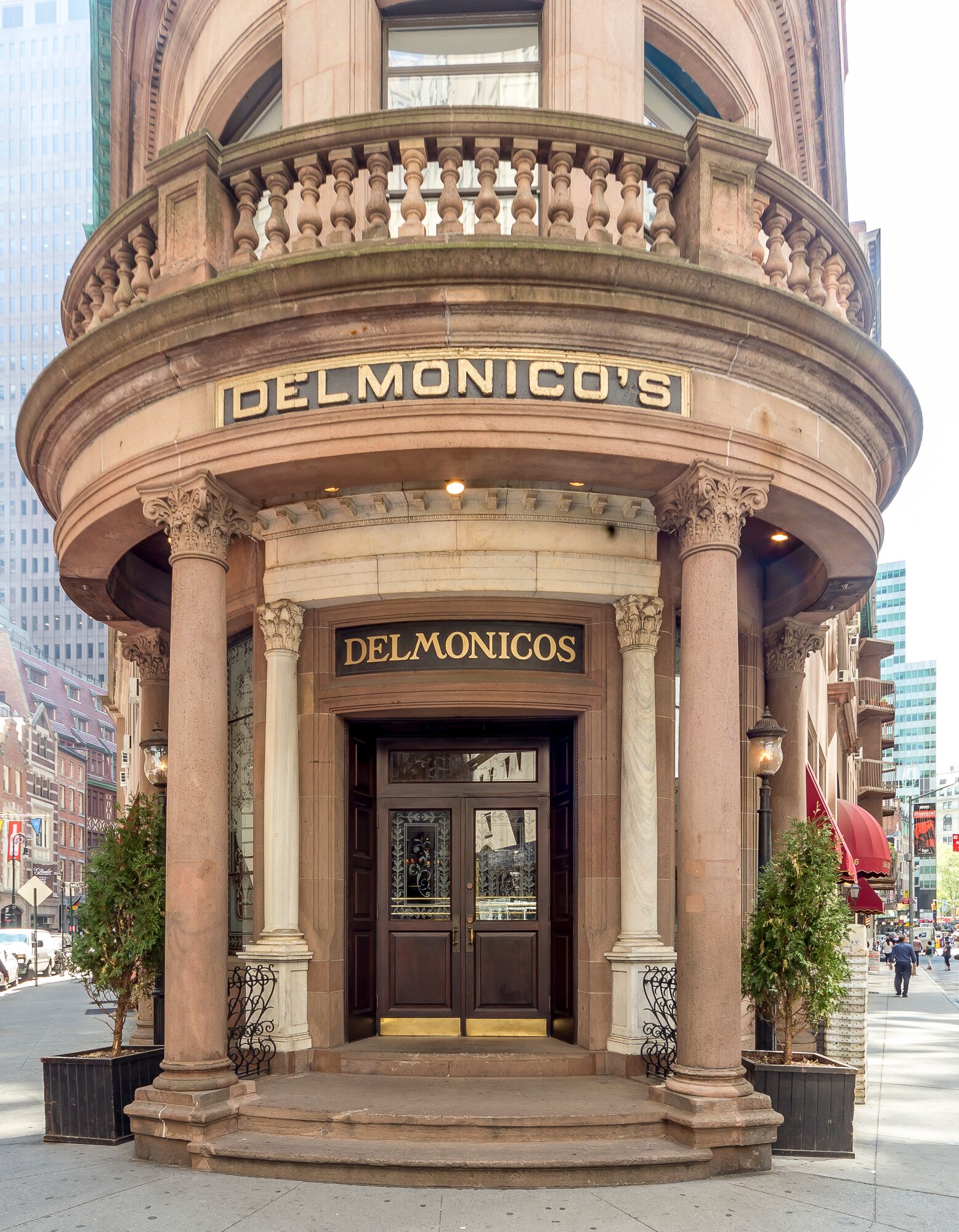 After four years it had become a
full-fledged restaurant with white
tablecloths, a French chef, female cashier,
revolving doors and a number of then-exotic
dishes that included salad and
green vegetables served in the French
manner--this at a time when the local
merchants ate outdoors or grabbed what they
could at a tavern or eating house.
After four years it had become a
full-fledged restaurant with white
tablecloths, a French chef, female cashier,
revolving doors and a number of then-exotic
dishes that included salad and
green vegetables served in the French
manner--this at a time when the local
merchants ate outdoors or grabbed what they
could at a tavern or eating house.
Delmonico’s was, then, the beacon of good taste and lavish meals, a standard for fine dining that had never existed before, and the brothers’ success begat ten more restaurants under their family name, each one more grandiose than the last, usually run by a relative imported for the purpose of maintaining tradition.
Everyone of importance went to
Delmonico’s: Theodore
Roosevelt,
Mark Twain, Diamond Jim Brady, Lillian
Russell, Charles Dickens,
Oscar Wilde, J.P. Morgan, Prince Edward
VII of
Wales and Napoleon III of France. It was the
first restaurant to allow women to dine
together with men, and it was from a
room in Delmonico’s that Samuel F. B. Morse
sent the first cablegram across the
Atlantic from its 14th Street location.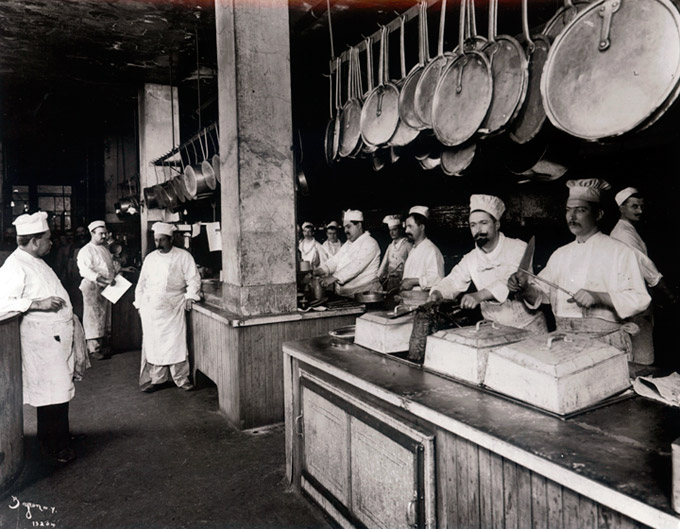
The menu evolved into several pages, with nearly thirty poultry dishes, eleven beef dishes and sixteen pastries listed, and the restaurant’s French cooking set the mold for American deluxe dining rooms that has been maintained ever since. The Delmonico steak and Delmonico potatoes, eggs Benedict and lobster Newburg were created there, and an early version of Baked Alaska debuted in its dining rooms. Last year Delmonico’s was honored in the superb food history Ten Restaurants That Changed America by Paul Freedman.
Sadly, the onset of Prohibition forced the closure of Delmonico’s—no one wanted to dine like that without wine and whiskey—but it re-opened in 1927 on Beaver Street, closed again, and re-opened with successive owners—but only three in all its history. Today it is owned and operated by the Turcinovic family, who suffered through not only the near collapse of the neighborhood on 9/11—they lost a huge percentage of their wine cellar and had to completely restore the dining rooms—but also the economic crash of 2008.
Today, however, with Dennis Turcinovic in constant overview and Chef Billy Oliva in the kitchen, Delmonico’s shines as brightly as it did in the 19th century, its clientele a mix of beefy, loud Wall Streeters, the new locals who have moved to the area, and tourists from all over the world who bask in a style of décor and dining comparable only to that of Keen’s Chop House, which opened in 1885.
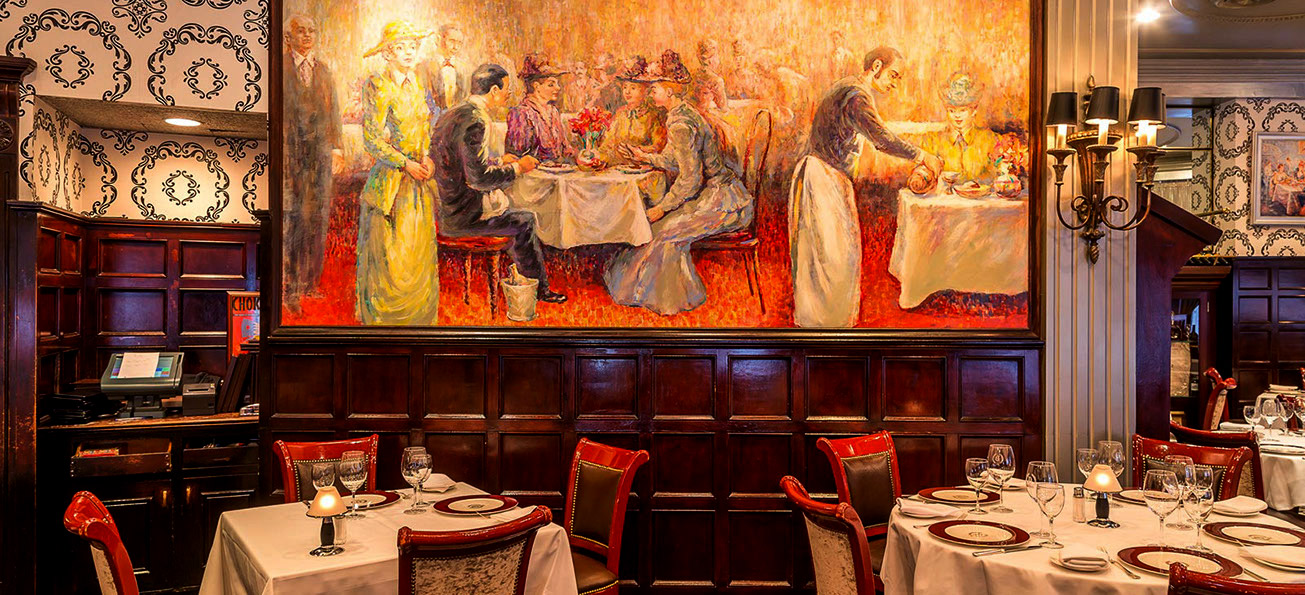 When
you enter Delmonico’s
through a portal with marble columns brought
from Palermo, a wide, deep dining
room opens up, with murals of noted
celebrities who once dined there, broad
tables with heavy linens, a marble fireplace,
wrought iron staircase leading to
private rooms, and golden lighting from above. Your greeting will be
genuine from everyone—Dennis
Turcinovic will undoubtedly come by—and
immediately a waitress will welcome you
and hand you menus and the wine list.
Ours, a Croatian woman named Marina,
didn’t flinch in answering any
question, historic or culinary, I could ask,
and our wine bottle was at our table
within three minutes.
When
you enter Delmonico’s
through a portal with marble columns brought
from Palermo, a wide, deep dining
room opens up, with murals of noted
celebrities who once dined there, broad
tables with heavy linens, a marble fireplace,
wrought iron staircase leading to
private rooms, and golden lighting from above. Your greeting will be
genuine from everyone—Dennis
Turcinovic will undoubtedly come by—and
immediately a waitress will welcome you
and hand you menus and the wine list.
Ours, a Croatian woman named Marina,
didn’t flinch in answering any
question, historic or culinary, I could ask,
and our wine bottle was at our table
within three minutes.
Having not dined at Delmonico’s in
several years, I was very glad to see it
vibrant with business and looking as
if it had been opened that very day.
The festive atmosphere is ever present,
any day of the year, and I can
only imagine the room’s beauty 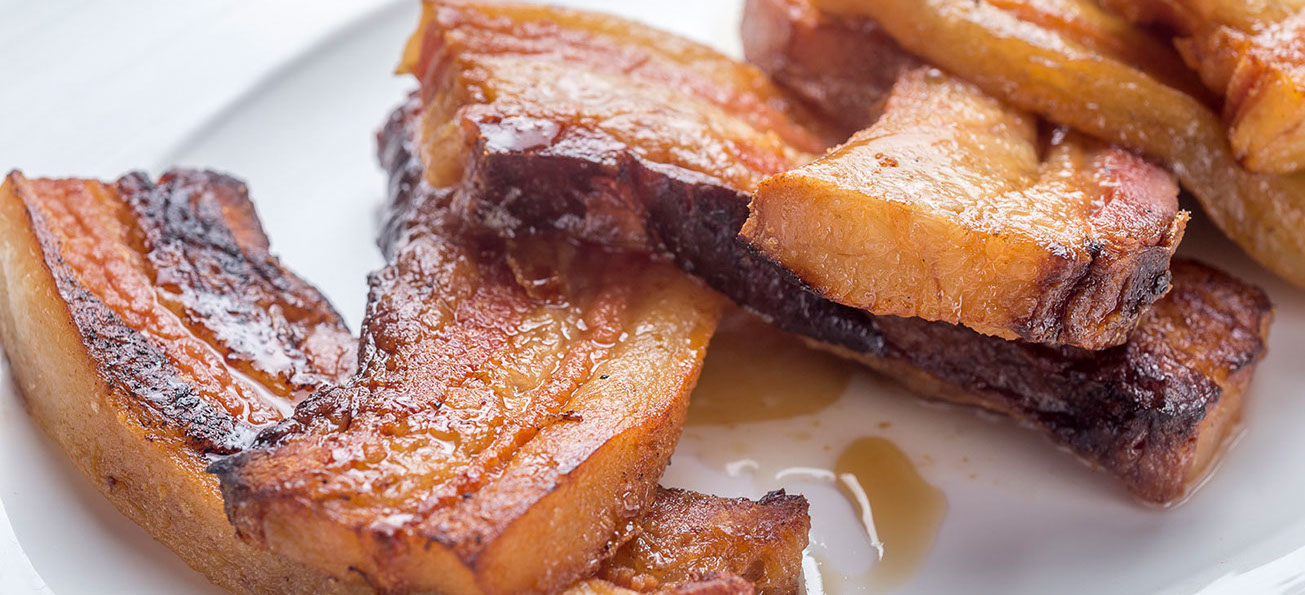 at Christmastime.
at Christmastime.
My party of four focused on Delmonico’s signature dishes, not least the crisp iceberg wedge salad with very good Bayley Hazen blue cheese dressing, pickled onion and crumbled bacon. A tower of shellfish ($60 or $120), with three dipping sauces, was picked clean, and tuna tartare was very nicely seasoned and came with a rice puff and sriacha aďoli ($22). The house-cured bacon ($29) will feed four (right) handily.
As for the Delmonico
steak (below),
its original cut and configuration--a primal
short loin--has changed over years and lost
its
meaning , so we opted for a 24-ounce 45-day
dry aged bone-in ribeye ($65) of
very fine flavor and texture (though, frankly,
I’ve yet to taste any distinct
effect on a good piece of beef after 28 days,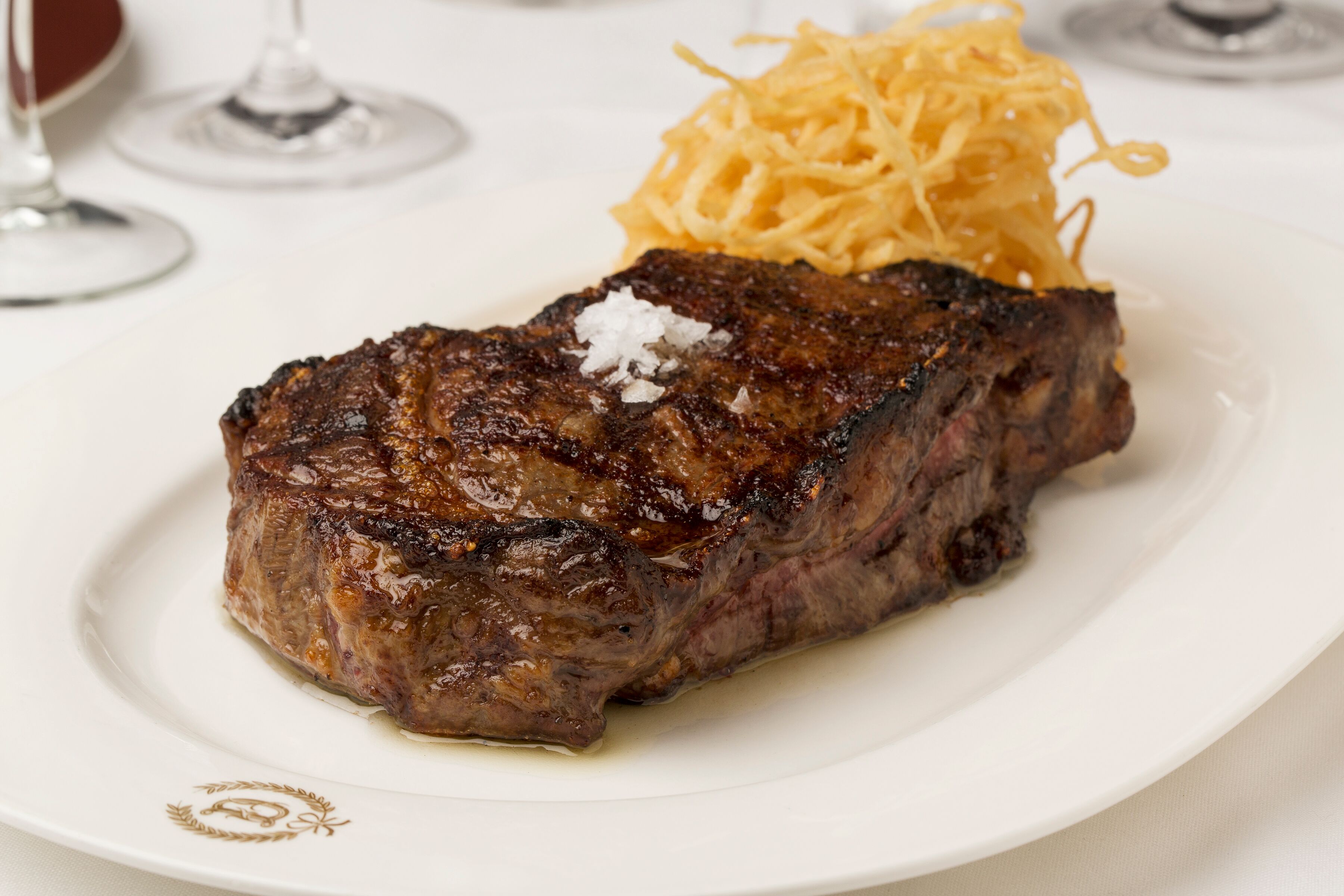 and there’s that
option at $58).
Colorado lamb chops ($49)—four gargantuan
ribs—were impeccably trimmed and came
atop wilted seasoned spinach.
and there’s that
option at $58).
Colorado lamb chops ($49)—four gargantuan
ribs—were impeccably trimmed and came
atop wilted seasoned spinach.
I usually prefer my lobsters unsullied, but lobster Newburg (MP)—actually named after a regular patron named Wenberg who displeased the Delmonicos, who thereupon changed the name—is one of those sumptuous 19th century-style dishes, like lobster Thermidor. When prepared with care so as not to overcook the three-pound lobster’s meat in the body and claws, it is always impressive. Its blend of cream, sherry, cayenne and tarragon (below) is exactly the kind of trencherman fare gargantuans like Diamond Jim Brady lapped up at Delmonico’s.
So it was to be expected
that a dish of crispy red snapper with coconut
green curry, forbidden rice and
shaved vegetables ($38) would pale by
comparison.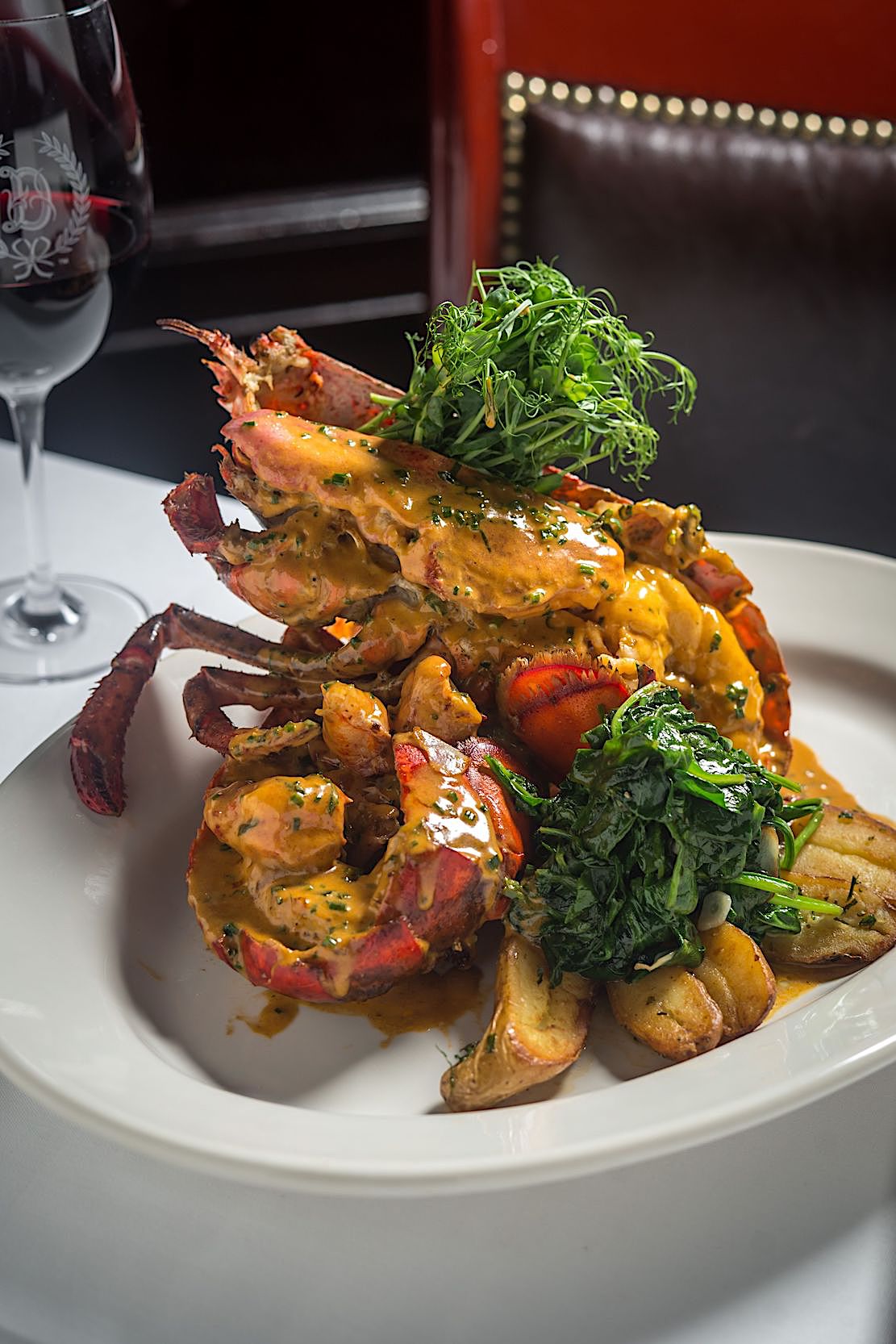 Do
go for the onion rings with buttermilk blue
dressing (a
hefty $19!), the Brussels sprouts ($12) and
the béchamel cream-rich Delmonico
potatoes ($13).
Do
go for the onion rings with buttermilk blue
dressing (a
hefty $19!), the Brussels sprouts ($12) and
the béchamel cream-rich Delmonico
potatoes ($13).
Attention must be paid to the desserts at Delmonico’s. The baked Alaska ($13) set on a walnut cake, with apricot jam, banana gelato and browned meringue (below), created in 1867 after the purchase of Alaska by the U.S., used to be flamed at the table, but the NYC Fire Department did not take kindly to that traditional display. The cheesecake with a sesame tuile, mango-passionfruit coulis and macadamia-pine nut crust ($12) and the chocolate raspberry fondant with dark chocolate ganache and raspberry ice cream ($12) are less dramatic but delicious. Six artisanal cheeses are also offered (at $30).
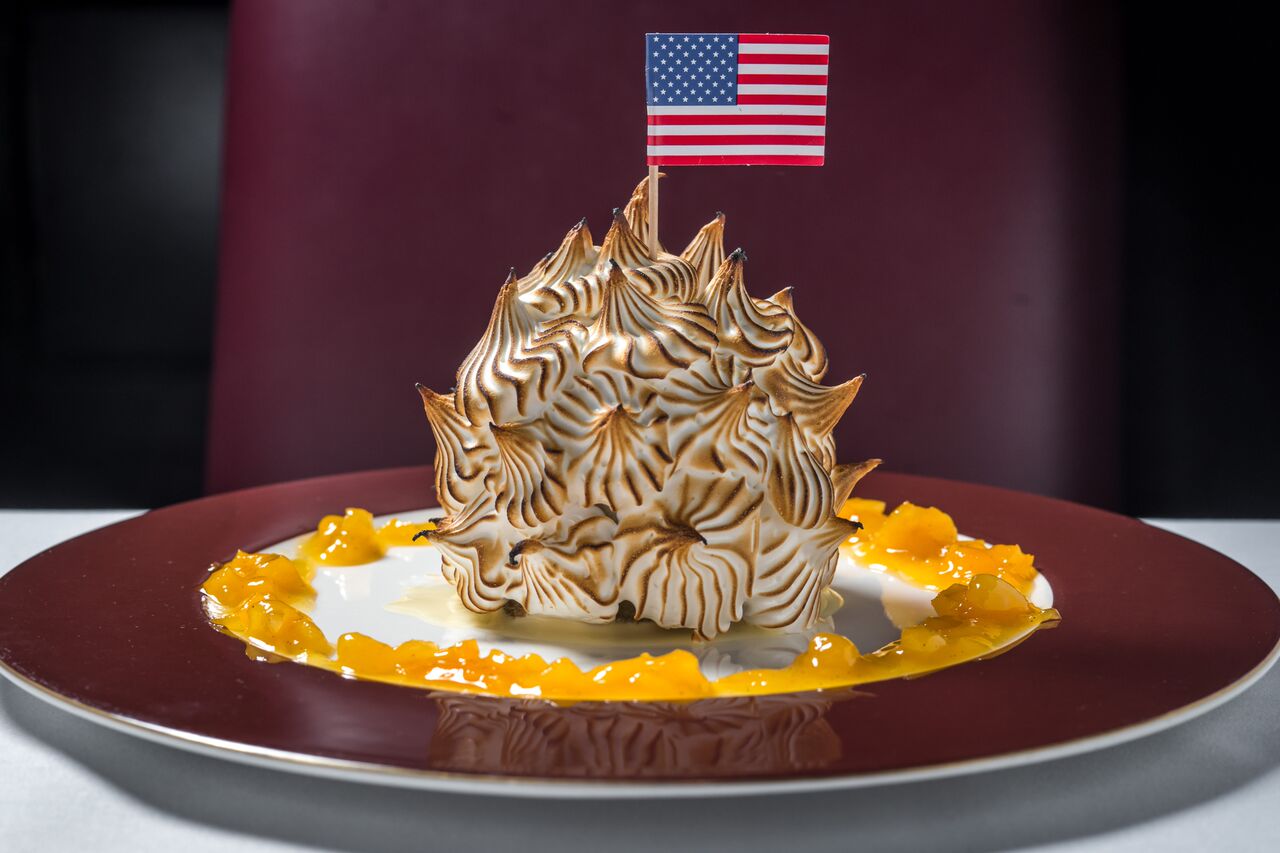 Delmonico’s
wine list—severely diminished
during the 9/11 disaster that affected so much
of the neighborhood—is back up
to world class ranking, 28 tightly packed
pages with marginal notes on
various kinds of wines. All the California
cult wines are here, as well as two
dozen prestige cuvée-quality Champagnes.
There aren’t a lot of bottles under $70
and mark-ups vary, not as high
as some elsewhere but certainly pricey.
A store-bought Cakebread Cellars
Chardonnay 2013 at $40, is here $105; a
$120 Heitz Cellars Martha’s Vineyard 2009 will
set you back $525 at Delmonico’s.
Delmonico’s
wine list—severely diminished
during the 9/11 disaster that affected so much
of the neighborhood—is back up
to world class ranking, 28 tightly packed
pages with marginal notes on
various kinds of wines. All the California
cult wines are here, as well as two
dozen prestige cuvée-quality Champagnes.
There aren’t a lot of bottles under $70
and mark-ups vary, not as high
as some elsewhere but certainly pricey.
A store-bought Cakebread Cellars
Chardonnay 2013 at $40, is here $105; a
$120 Heitz Cellars Martha’s Vineyard 2009 will
set you back $525 at Delmonico’s.
This fall Delmonico’s will celebrate its 180th birthday, with a few time-outs along the way that suggested such a wondrous place could not possibly survive into the 21st century. Of course, the NYC food media seems to believe it must have gone under decades ago. But when all the 20-seat Asian noodle eateries in Soho and the Nordic follies n Tribeca disappear month by month, Delmonico’s doors will still open way at the foot of Manhattan, where it all began, onto something not just rare but as exciting as it ever was.
❖❖❖
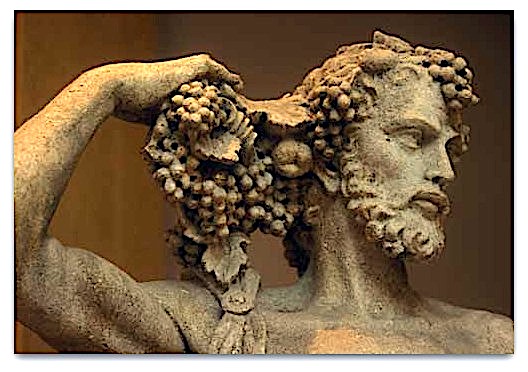
THE WINES OF ROME, Part Two. . . and Roman Food as Well
By John A. Curtas
If
Cincinnato and Marco Carpineti,
of which I wrote in my last article,
represent Roman vintners moving
forward by looking to the past, Casale
Del Giglio is a winery of a much
more modern stripe. Located on the slopes
and
plains and some former marshland some 30
miles south of Rome, the vineyard
utilizes its 445 acres of vines to make an
assortment of varietals that stretch
the boundaries of what Italian wines can be.
Along with wine journalist Charles
Scicolone, my wife and I toured the winery
with winemaker Paolo Tiefenthaler,
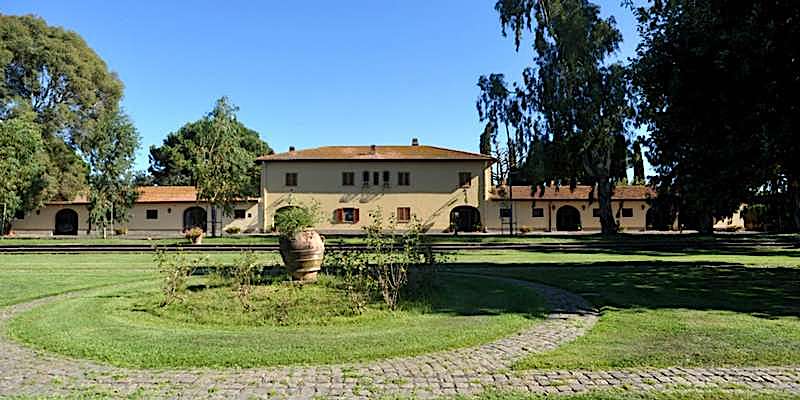 who explained that
the area, being located on sandy soil in the
Agro Potino
valley near Anzio, did not have much of a
wine-making tradition before they
started cultivating it back in the 1990s.
Tiefenthaler told us through an
interpreter that they saw this unexplored
territory as being perfect for
viticultural experimentation, having a
temperate maritime climate similar to
those found in Australia, California and
Bordeaux. As a result, and with the
full blessing of the European Union, over
sixty different varietals were
planted to see what grew and tasted best. With
such a broad canvas to work
from, Tiefenthaler arrived at a stunning
assortment of wines—fifteen in
all—that aim to bridge the gap between classic
and international tastes, as
well as solidifying the area as a microclimate
to be taken seriously.
who explained that
the area, being located on sandy soil in the
Agro Potino
valley near Anzio, did not have much of a
wine-making tradition before they
started cultivating it back in the 1990s.
Tiefenthaler told us through an
interpreter that they saw this unexplored
territory as being perfect for
viticultural experimentation, having a
temperate maritime climate similar to
those found in Australia, California and
Bordeaux. As a result, and with the
full blessing of the European Union, over
sixty different varietals were
planted to see what grew and tasted best. With
such a broad canvas to work
from, Tiefenthaler arrived at a stunning
assortment of wines—fifteen in
all—that aim to bridge the gap between classic
and international tastes, as
well as solidifying the area as a microclimate
to be taken seriously.
One
very un-Italian thing about Casale Del
Giglio's wines are
the labels. In a nod towards the international
market—and in breaking with the
traditional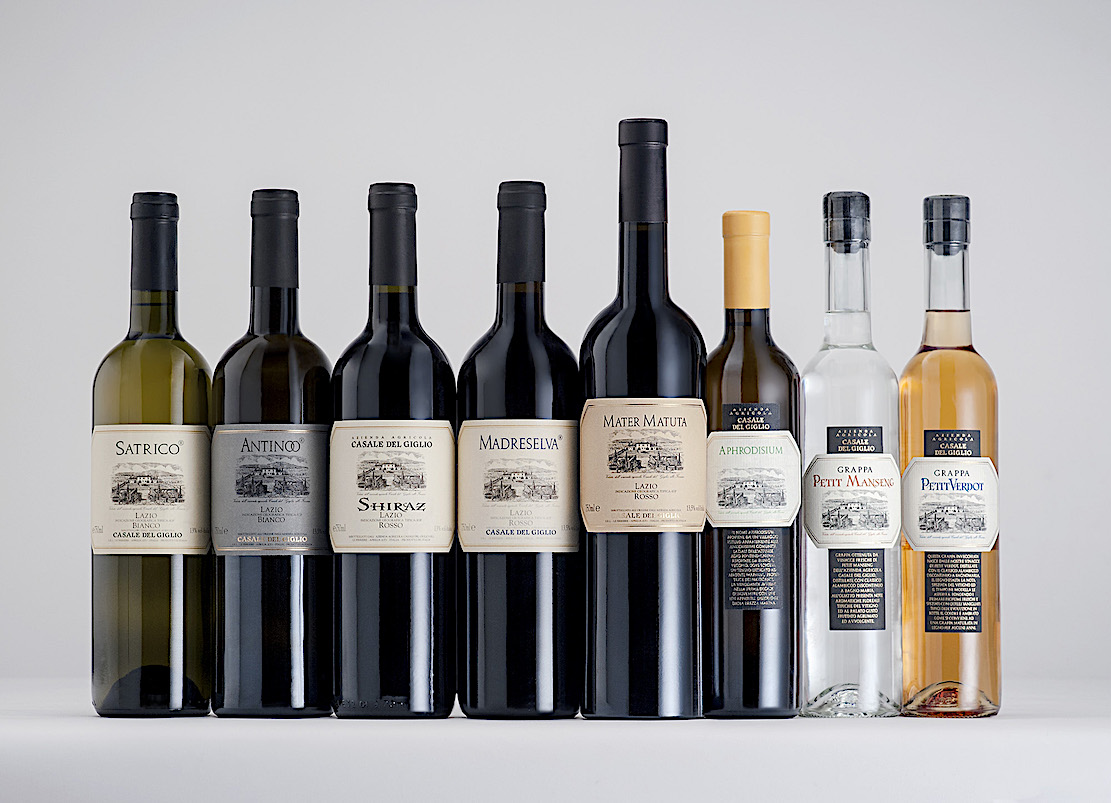 Italian wine labels whose motto has always
been "obscurity and
confusion over clarity and information"—his
bottles identify the maker,
the grape (if it's not a blend) and the
location of the vineyard. Most of the
wines are classified as IGT (Indicazione
Geografica Tipica), which allots more
freedom to winemakers to use different grapes
and blends than the more
restrictive DOCG and DOC denominations.
Italian wine labels whose motto has always
been "obscurity and
confusion over clarity and information"—his
bottles identify the maker,
the grape (if it's not a blend) and the
location of the vineyard. Most of the
wines are classified as IGT (Indicazione
Geografica Tipica), which allots more
freedom to winemakers to use different grapes
and blends than the more
restrictive DOCG and DOC denominations.
Tiefenthaler takes that
freedom and runs with it. His chardonnay uses
no oak and goes through no
malolactic fermentation. The result is a
full-bodied, crisp wine that is a pure
expression of the grape. It was one of many
non-traditional wines I tasted that
caused me to sit up and take notice. Just as
pleasantly surprising was the
Albiola Rosato,
a rosé of Syrah
and Sangiovese grapes, that was surprisingly
rich for a wine so pink. Its
strong acidity and raspberry/strawberry aromas
make it a perfect wine for
sipping all summer long.
On
the more traditional front,
Casale Del Giglio weighs in with a big, spicy,
tannic, vaguely herbaceous
Cesanese that Elise Rialland, our
winery guide for the day, said goes perfectly
with a spezzatino
di bufaletta
dell'agro pontino (water buffalo
stew). Absent any water buffalo in your
neighborhood, a beef stew would match
splendidly as well.
Of the other red wines we tasted,
the huge, sweetly tannic Tempranijo was a
monster that needs taming by food or
aging, and the 100% Cabernet Sauvignon showed
promise as well, although, like
many of the reds, it seemed quite young, very
fruit-forward and a bit rough
around the edges. Still, when you consider
that these wines retail for well
under $20 a bottle, you're getting quite a
mouthful for the price.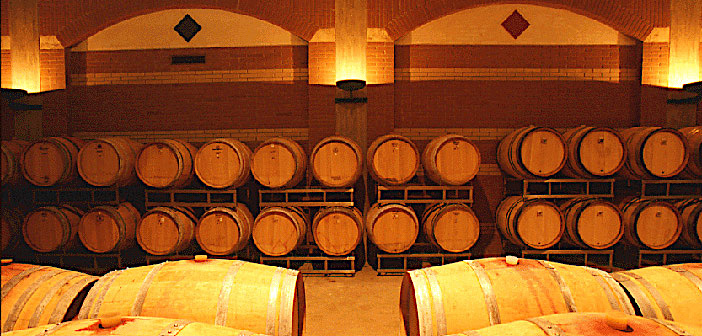
Two wines that need no qualifiers
are the Bellone and Mater Matuta. The Bellone
is yet another worthwhile way to
break the bonds of your chardonnay, sauvignon
blanc, or pinot grigio habit,
being a complex and subtle blend of ripe
tropical fruit beneath a nicely floral
nose. What sets it apart from your
run-of-the-mill $15 white wines is the
strong acidity and a bracing finish that
tastes like a sea breeze smells. I
can't think of a better wine to accompany a
fish stew or raw seafood platter.
If the Bellone is an ode to the ancient
varietals of Lazio, the Mater Matuta
represents a leap into the 21st Century.
Elegant and powerful, this flagship wine is a
blend of 85% Syrah and 15% Petit
Verdot, and displays a deep, dense, ruby red
color, and complex aromas of black
cherry, coffee and about half a spice rack.
The tannins are finely integrated
and the finish lasts for days. In all, quite a
bottle for $50, and quite a
landmark for an area that had no idea it could
make such a splash with grapes
that had never before spoken Italian.
Old
school or new, Roman wines
have broken the shackles of cheap white wine
that defined its viticulture for
so long. Tasting the full panoply of Casale
Del Giglio wines (including a
wonderful late harvest wine called
Aphrodisium) taught me that no longer will I
look past the "Lazio" designation when I see
it in a wine store or on
a list. These are very attractive wines at
very attractive prices, and all of
them are made to match with Roman food, one of
the world's great cuisines.
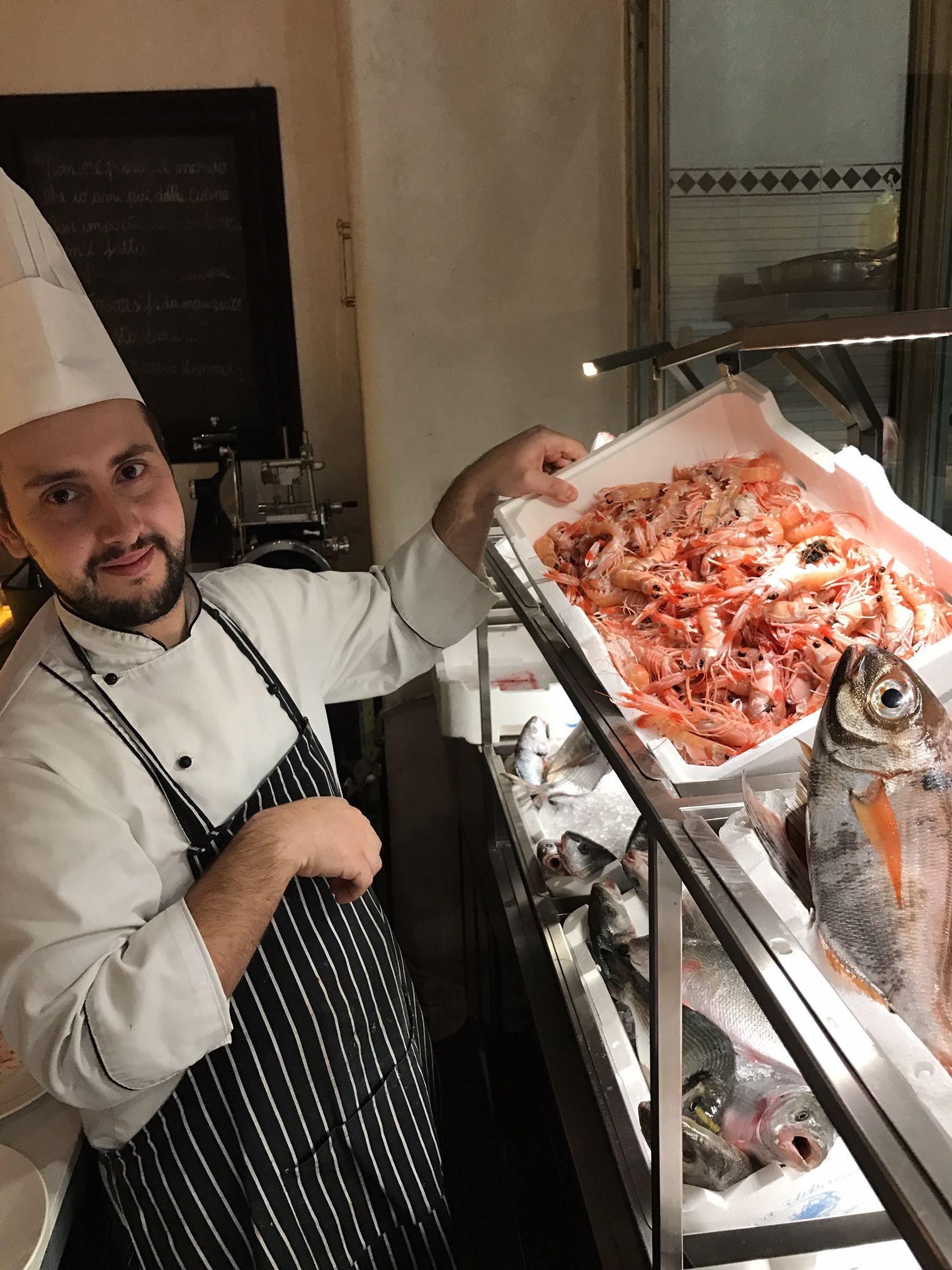 A FEW
WORDS ABOUT ROMAN RESTAURANTS. . . .
A FEW
WORDS ABOUT ROMAN RESTAURANTS. . . .
"To a Roman, wine is just
another form of food," Charles Scicolone
reminded me several times as we
tasted our way around Rome for a week. What he
also impressed upon me was that
Romans, who are very serious about their
cuisine, look upon wine as an
integral part of any meal. Still, being
Romans, they don't exactly stress out over it.
You'll never find a Roman
dissecting the fine points of a food and wine
match. Certain fundamental rules
are followed: lighter wines with fish, heavier
ones with meat, but after that,
it is all about enjoying them simultaneously.
Here are a few restaurants and
wine bars where you can maximize your
enjoyment of both in the Eternal City.
Il Sanlorenzo--4/5, Via dei
Chiavari; 39 06 68 65 097. Despite being
45 minutes from the ocean, Rome has never been
much of a seafood town, until now. This
elegant, seafood-centric place, a block
off of the Corso Vittorio Emanuele II, proudly
displays the daily catch at the
front bar, offers six kinds of Le Acque
(mineral water), artisanal breads and a
stunning selection of raw seafood. It's 85€
tasting menu is quite the bargain,
and the modernist carpaccio of red shrimps is
just as satisfying as the artful
twist on linguine con vongole.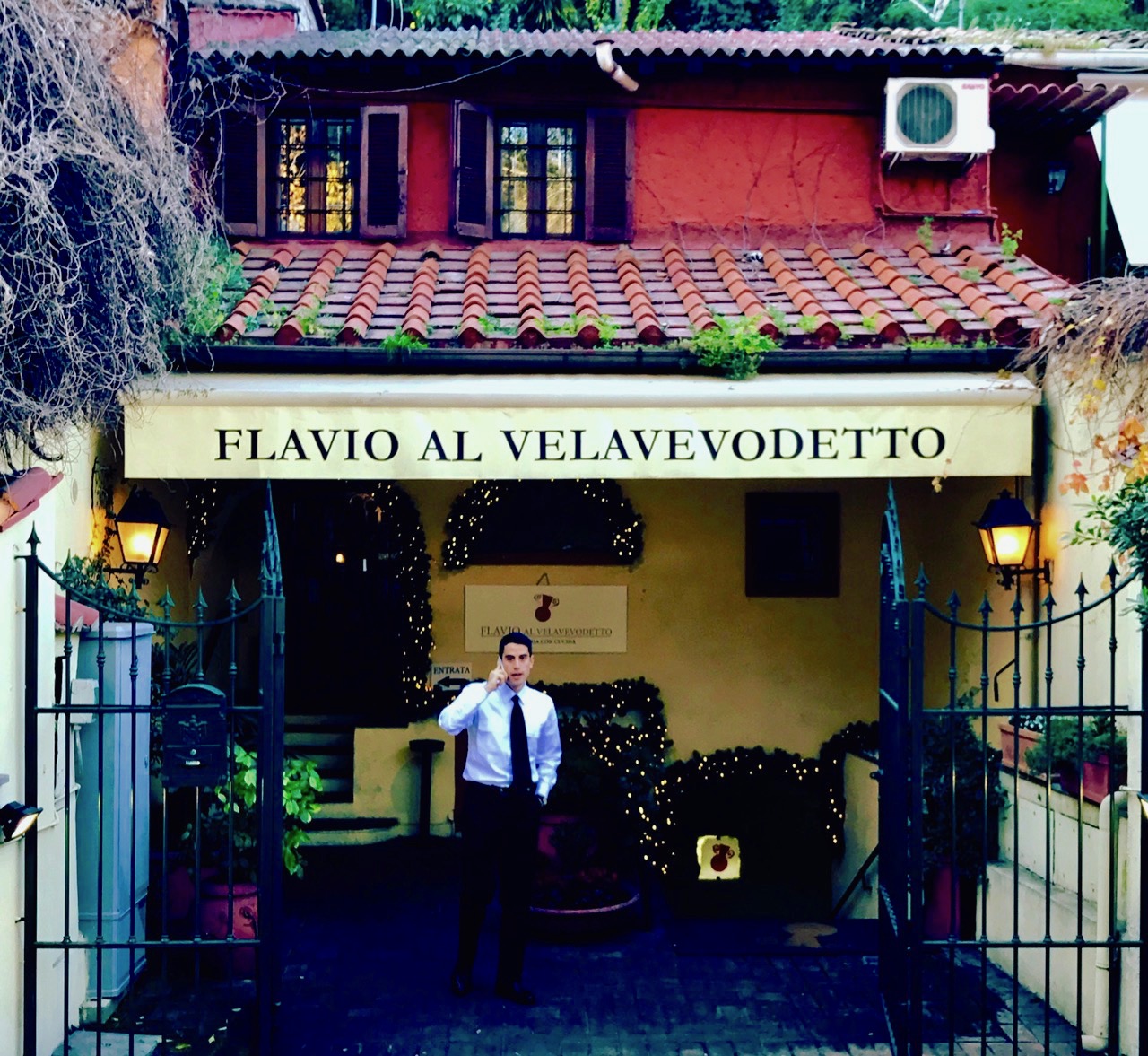
Flavio al
Velavevodetto --97, Via di Monte
Testaccio; 39 06 574 4194. The trouble with
traveling to Rome, as with New York, Paris,
and
Tokyo, is I'm always torn between classic
places to which I can't wait to
return and
wanting to try out
newer joints that everyone is raving about. I find that Rome doesn't
follow food trends as much as the
rest of the world, so it's easier to ignore
whatever some travel magazine is
writing about this month. Flavio Al
Velavevodetto has been around forever, and
isn't on anyone's thrill
list, but the
food is Roman to the core. A wall of
wines greets you as you enter (and
doubles as the wine list) and the menu
couldn't be simpler. The rigatoni
con la pajata (with veal
intestines) and coda alla
vaccinara
(braised oxtail) also could not be any better.
"Velavevodetto" means something
like a Roman "I told you
so," and after two bites of your meal, you
will have to admit that I told
you so.
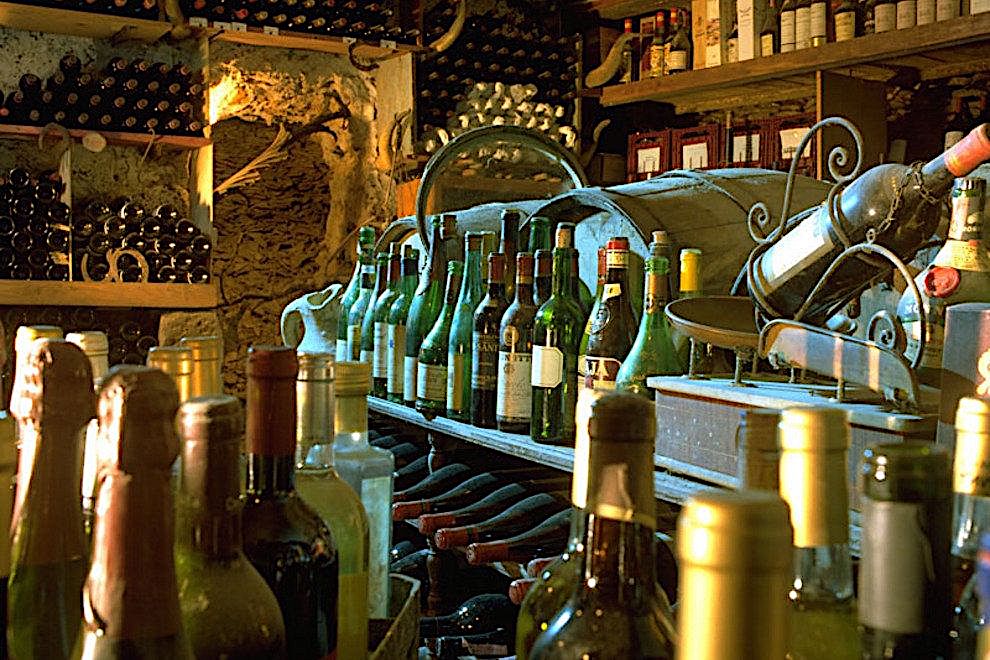 Checchino
dal 1887 --30, Via di Monte Testaccio; 39 06
574 3816. Right around the corner from Flavio
al Velavevodetto is this
venerable establishment, which is just as
comfortable and just as good.
Specializing in the "fifth quarter" of the
animal, the menu is a
testament to how Romans were into offal long
before it became fashionable.
Wonderful wine list as well (left).
Checchino
dal 1887 --30, Via di Monte Testaccio; 39 06
574 3816. Right around the corner from Flavio
al Velavevodetto is this
venerable establishment, which is just as
comfortable and just as good.
Specializing in the "fifth quarter" of the
animal, the menu is a
testament to how Romans were into offal long
before it became fashionable.
Wonderful wine list as well (left).
Dal Bolognese --1, Piazza del
Popolo; 39 06 361 1426. I never go to Rome
without taking at least one meal here.
Directly off the Piazza del Popolo, it is a
fashionable haunt of power lunchers
and well-healed shoppers. The thing to get is
the bollito misto with mostarda
and
salsa
verde. There might be other
good things to eat on the menu, but this meat
platter with mustard fruits is so
spectacular I can't even think of ordering
anything else. Except 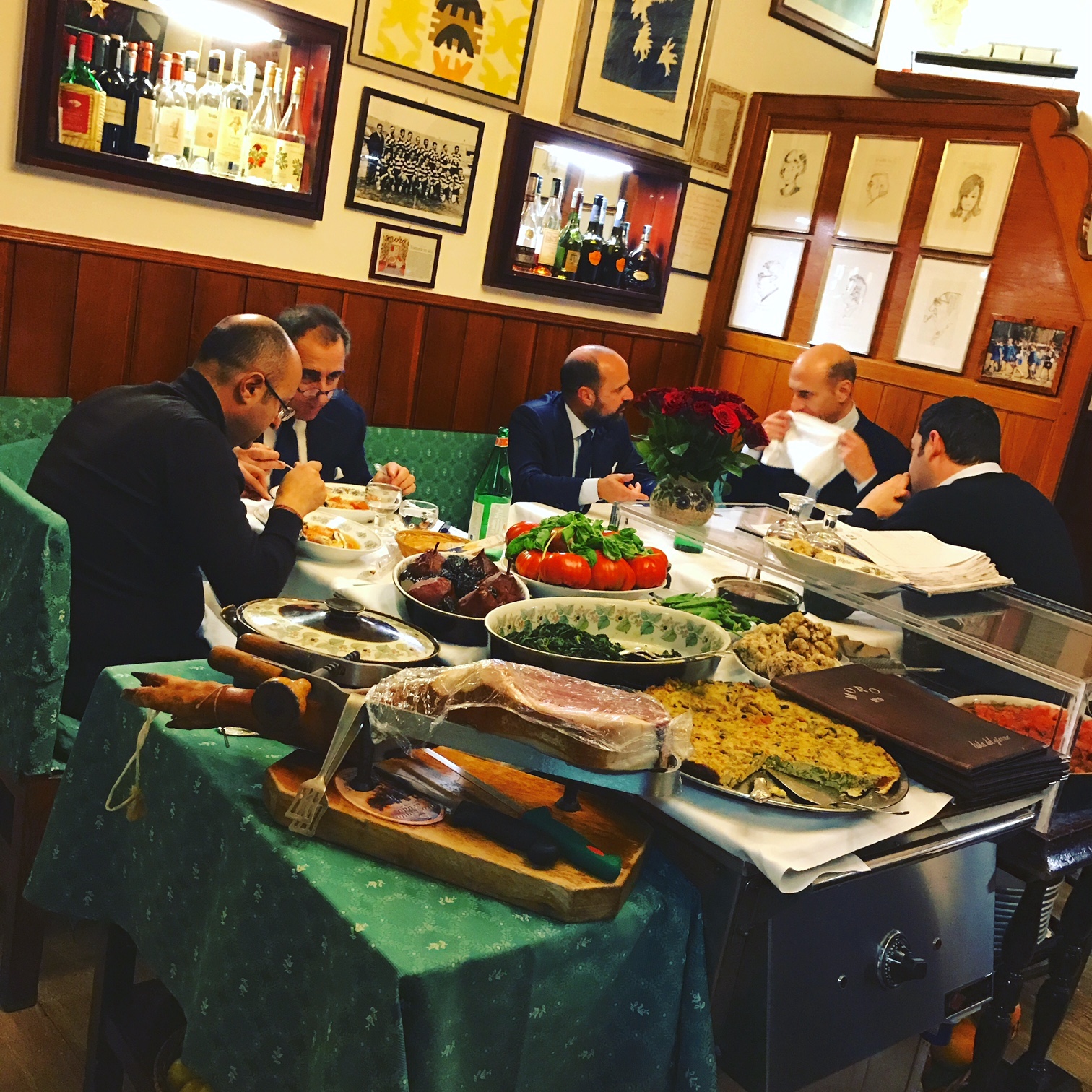 the fritto
misto (fried seafood); it's
out-of-this-world too.
the fritto
misto (fried seafood); it's
out-of-this-world too.
Al Moro --13, Vicolo
Bollette; 39 06 678 3495. There is an old
saying about Roman restaurants, that the worse
the
art is on the walls, the better the food. Al
Moro's walls (right) won't win any awards,
but the fegato
(calf’s liver with agrodolce
onions) ought to be enshrined
somewhere. You won't find better culatello
ham or buffalo
mozzarella anywhere
else around the Trevi Fountain, either. Go
early for lunch to see how the smart
business set enjoys its midday repast.
. . .
A FEW MORE WORDS ABOUT ROMAN WINE BARS
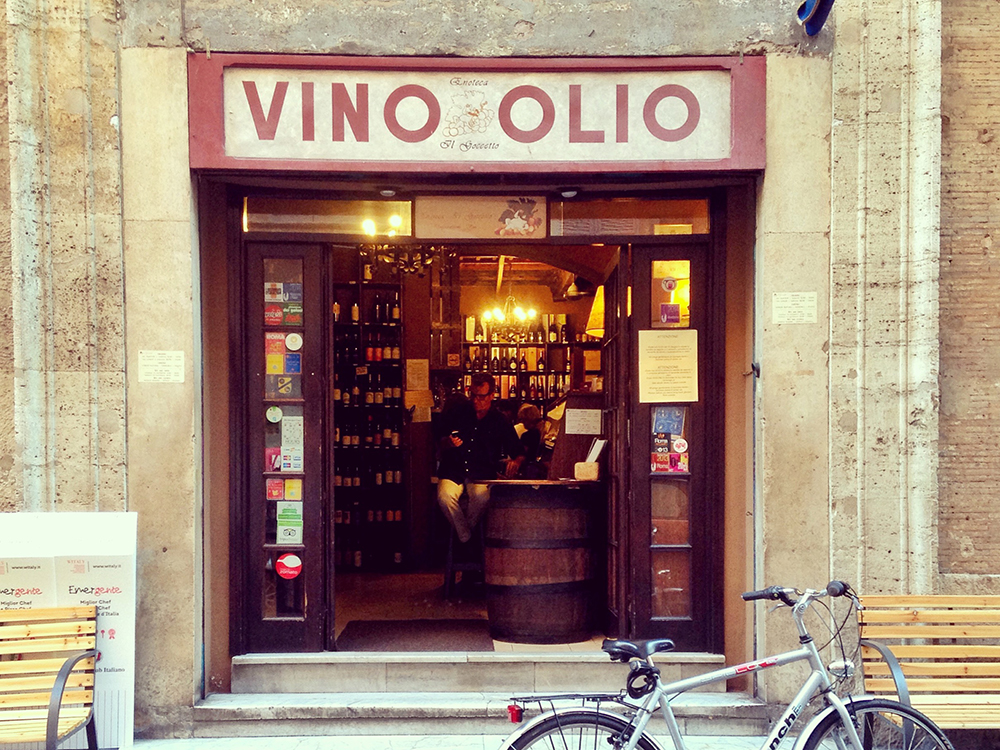 Roman ristoranti are far less formal
affairs than their Parisian
counterparts. Still, you're expected to order
two or three courses in them, and
they are not the place to pick up a light
bite. For that you have pizzerias and
espresso bars everywhere (of variable
quality), but for my money, wine bars are
the way to go if you want a simple snack or
plate of pasta without a lot of
fuss after dark. The bonus is, of course, they
also have incredible wine
selections, some real bargains by the glass or
carafe, and no one frowns at you
if you just want a small plate of some
incredible artichoke ravioli with a
Gravner Breg like we had L'Angolo Divino. The
other bonus is these spots are
all within a short walk of each other in the
Centro Storico.
Roman ristoranti are far less formal
affairs than their Parisian
counterparts. Still, you're expected to order
two or three courses in them, and
they are not the place to pick up a light
bite. For that you have pizzerias and
espresso bars everywhere (of variable
quality), but for my money, wine bars are
the way to go if you want a simple snack or
plate of pasta without a lot of
fuss after dark. The bonus is, of course, they
also have incredible wine
selections, some real bargains by the glass or
carafe, and no one frowns at you
if you just want a small plate of some
incredible artichoke ravioli with a
Gravner Breg like we had L'Angolo Divino. The
other bonus is these spots are
all within a short walk of each other in the
Centro Storico. 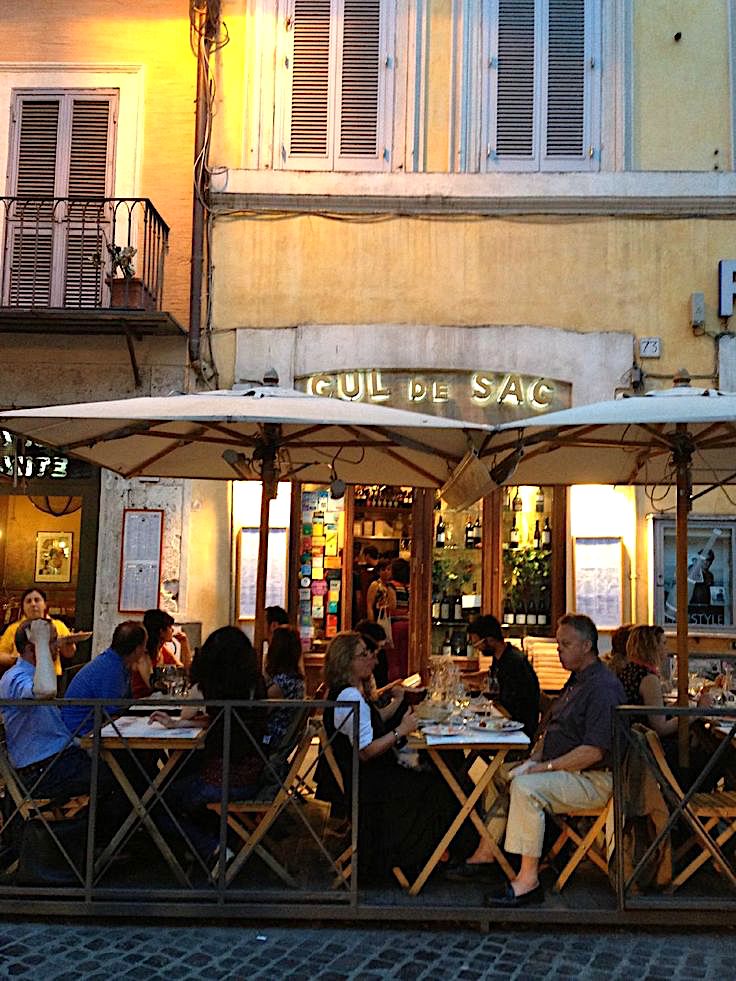
Il Goccetto (left)
--14, Via dei Banchi Vecchi; 39 06 686 4268.
Very popular with the young crowd. Doubles as
a wine store. Nice
antipasti display counter as you enter. Go
early or late and go with a thirst.
Enoteca Cul de Sac --13, Vicolo
Bollette; 39 06 678 3495. An old favorite off
the Piazza Navona. Friendly welcome. Outdoor
seating. Rome's first proper wine bar
(since 1977) is still one of the
best, with food a lot better than you expect
it to be.
L'Angolo Divino --Via del
Balestrari; 06 68 64 413. A cozy spot right
off the Camp de' Fiori, the modest entrance
gives
you not a clue as to the beauty of the food
and the wine selection. An
incredible list with a very helpful staff.
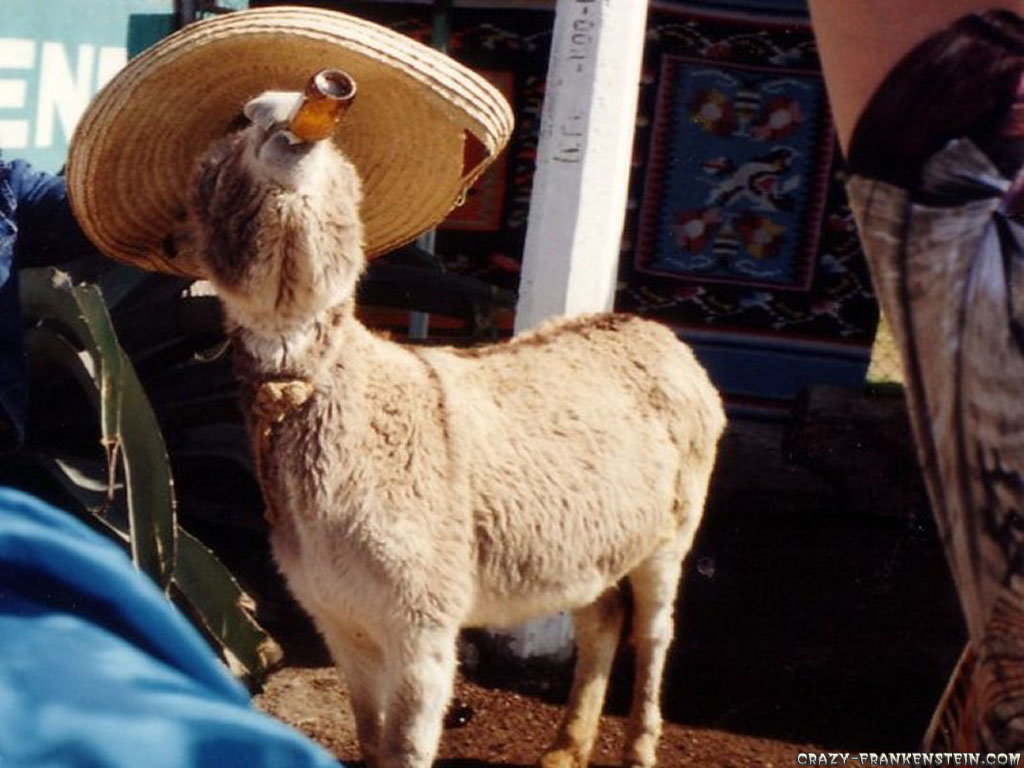
FOOD WRITING 101: DO
NOT ASSUME
YOUR READER IS A JACKASS
“There's
a
Way to Order Wine on a First Date without
Looking Like a Jackass”—Jeremy Rapanich, Esquire.com
(3/2/17)
AND WHILE
WE'RE ON THE SUBJECT OF JACKASSES. . . 
Planet Hollywood, once with 100 restaurants, now down
to six, is spending
SPRING IS HERE AND SO ARE WONDERFUL CHILEAN WINES
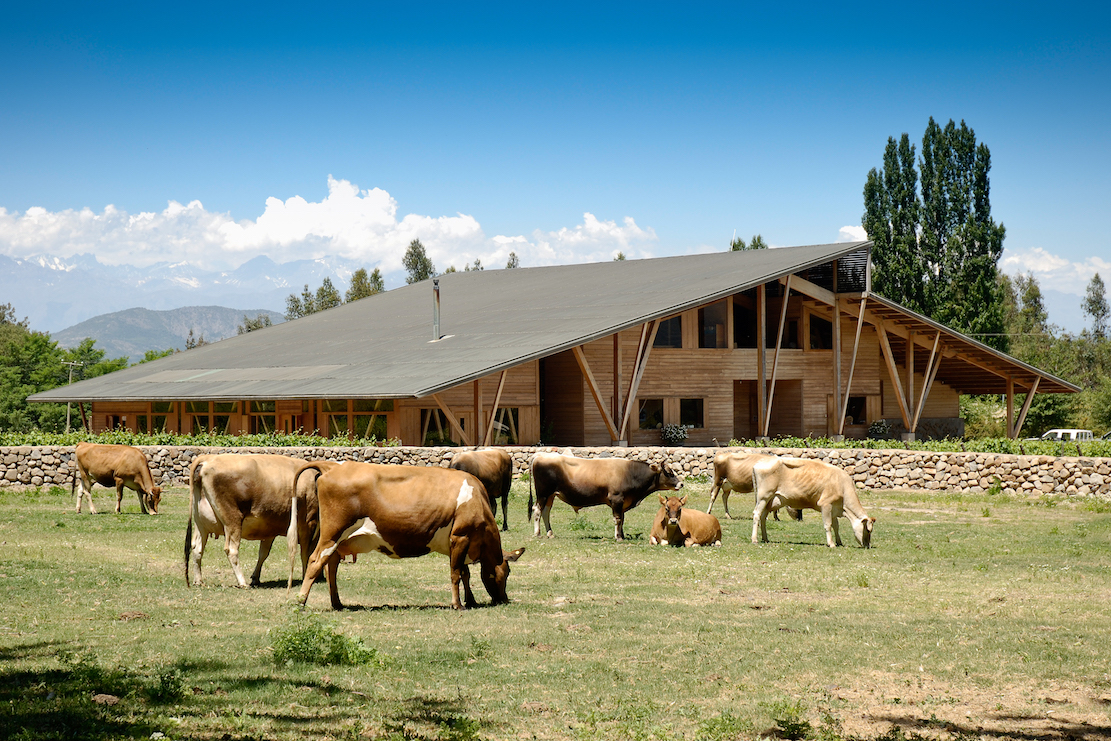 As Spring
finally kicks into gear, we are reminded of the
fragility of Mother Earth and
her bounty. As an importer representing
several family wine makers from
around the globe, I often like to point out that all
the wines that we
represent are green, some of them greener than
others. The greenest of
all are classified as Biodynamic or certified
Organic. One of the most
interesting selections of eco-balanced, organic and
biodynamic wines comes to
us from Chile and the vineyards of Emiliana.
As Spring
finally kicks into gear, we are reminded of the
fragility of Mother Earth and
her bounty. As an importer representing
several family wine makers from
around the globe, I often like to point out that all
the wines that we
represent are green, some of them greener than
others. The greenest of
all are classified as Biodynamic or certified
Organic. One of the most
interesting selections of eco-balanced, organic and
biodynamic wines comes to
us from Chile and the vineyards of Emiliana.
Emiliana was founded by our friends, the
Guilisasti family, who have a
long and proud history of winemaking with their
Concha y Toro brand.
Three decades ago, well ahead of the curve that has
made organic wines all the
rage today, they set up dedicated and, most
important for organic farming,
isolated vineyards for this type of
agriculture. Many may picture the
small farmer as being the most “organic,” but in the
reality of our wine world,
sometimes it takes the “big guys” to act as a
locomotive to get a movement such
as this on track.
Organic farming
is a form of agriculture
which avoids or largely excludes the use of
synthetic fertilizers and
pesticides, plant growth regulators, and livestock
feed additives.
Organic farmers rely on
crop rotation, crop residues, animal
manures--including llamas (below)--and
mechanical cultivation to maintain soils
productivity and health, to supply
plant nutrients, and to control weeds, insects and
other pests. To call a
wine organic in the US, government regulation says
that it must be produced
from 95% organically grown ingredients with no added
sulfites. If you add
sulfites in the relatively minimal amount of 100
parts per million, you can
only say that the wine is “made from organically
grown grapes.” Now, not
to go into a chemistry lesson, but it is virtually
impossible to make a wine
without that modest dose of sulfites, at least if
you want to drink it beyond
ten feet of the cellar it was made in and wish it to
survive any moderate
amount of aging.
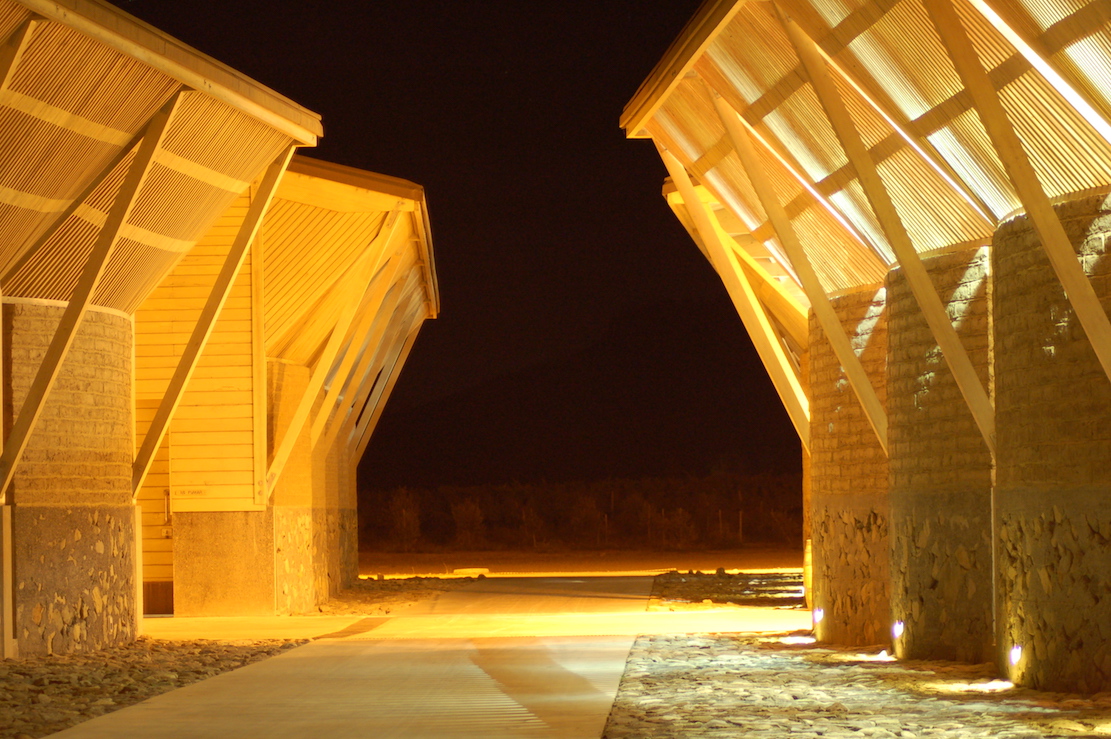
Biodynamic farming adheres
to the same principles, but takes it
one step further by relying on the cycles of the
moon and the sun to dictate
much of what is done in the field, and uses animal
treatments such as compost
teas, horns buried with fertilizer, deer bladders, etc.,
to treat the
soil. It may sound a little hocus pocus, but
in reality it is very
comparable to homeopathic medicine, using the body’s
(in this case, the earth’s)
own energy to heal itself.
Emiliana has four distinct
collections of lovingly crafted organic wine now
available in the US – the base
line of Natura, the next step up in Novas, a
stand-alone wine in Coyam, and the
ne-plus-ultra of bio-dynamic wines, Ge. One
taste of any of these and you
too may find yourself turning green – not with envy,
but for a newfound love of
organic winemaking!
Recommended – green
wines for Spring:
Natura Chardonnay In the cool coastal Pacific climate of
the Casablanca Valley,
organically grown grapes are hand picked during the
last week of March, and
vinified in stainless steel tanks, free of the
domineering influence of oak.
On the nose, tantalizing citrus aromas of grapefruit
and lime blend with notes
of pineapple, all of which reappear on the palate
and finish with balance
thanks to the wine’s freshness and natural
acidity. Delicious with spring
salads and seafood dishes.
Natura Carmenere – From the rustic isolation of the
Colchagua Valley, this
intense and voluptuous offers aromas of cherries,
chocolate and spice, coming
together in ramped up volume on the palate with
soft, round tannins and firm,
well-balanced structure. Great balance between
fruit and oak, with a
long, juicy finish.
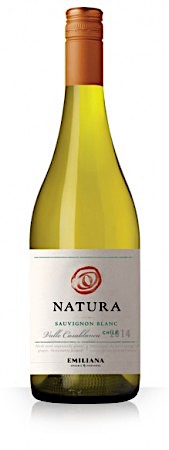 Novas
Sauvignon Blanc Gran Reserva – Hailing from the San Antonio Valley’s
thin
rocky and clay soils, the organic grapes for this
wine are harvested by hand in
March and undergo fermentation in stainless steel to
preserve their bright
fruit character. Herbal notes mixed with
citrus and soft floral hints
fill the bouquet; the taste is medium bodied with
grapefruit flavors joined by
a delicate acidity and a touch of minerality.
Novas
Sauvignon Blanc Gran Reserva – Hailing from the San Antonio Valley’s
thin
rocky and clay soils, the organic grapes for this
wine are harvested by hand in
March and undergo fermentation in stainless steel to
preserve their bright
fruit character. Herbal notes mixed with
citrus and soft floral hints
fill the bouquet; the taste is medium bodied with
grapefruit flavors joined by
a delicate acidity and a touch of minerality.
Novas Pinot Noir Gran
Reserva – The
grapes for this wine are grown in the
cool, coastal Casablanca Valley’s permeable sandy
loam soils, and harvested by
hand. After a cold soak on the skins, the wine
is aged for 8 months in
French oak barrels to add character, depth and
roundness.
Coyam – A
blend dominated by Syrah with nearly equal parts of
Carmenere and Merlot
balanced by “soupcons” of Cabernet Sauvignon,
Mourvedre and Petit Verdot, from
the Colchagua Valley estate called Los Robles –
Spanish  for the oaks,
called “Coyam” by the native Mapuche people in their
own language. Hand
harvested certified biodynamic grapes are naturally
fermented in French oak
barrels. Coyam is largely unfiltered and aged
for 13 months in barrels.
Aromas of ripe red and black fruits integrate with
notes of spice, earth and a
hint of vanilla bean. Elegant expressions of
fruit are delicately
interwoven with oak, mineral and toffee.
for the oaks,
called “Coyam” by the native Mapuche people in their
own language. Hand
harvested certified biodynamic grapes are naturally
fermented in French oak
barrels. Coyam is largely unfiltered and aged
for 13 months in barrels.
Aromas of ripe red and black fruits integrate with
notes of spice, earth and a
hint of vanilla bean. Elegant expressions of
fruit are delicately
interwoven with oak, mineral and toffee.
Ge – Chile’s
first certified biodynamic wine, the name Ge is a
nod to Geos, the earthly environment
pulling together all the elements that surround
us. Ge is a blend of
nearly equal parts of Syrah, Carmenere and Cabernet
Sauvignon grown in the deep
soils of colluvial origin in the coastal range,
which lends mineral complexity.
Naturally fermented in oak barrels, Ge is deep plum
red with violet tones; it
offers intense aromas of black fruits and berries
alongside mineral notes and a
soft touch of tobacco leaf. Generously fruity
with cedar notes, Ge is
well balanced with tremendous volume, well rounded
tannins and a long finish.
For more information
please visit http://www.banfiwines.com/winery/emiliana/
❖❖❖
Any of John Mariani's books below may be ordered from amazon.com.
 The
Hound in Heaven (21st Century Lion Books)
is a novella, and for anyone who loves dogs,
Christmas, romance, inspiration, even the supernatural, I
hope you'll find this to be a treasured favorite.
The story concerns how, after a New England teacher,
his wife and their two daughters adopt a stray puppy found
in their barn in northern Maine, their lives seem full of
promise. But when tragedy strikes, their wonderful dog
Lazarus and the spirit of Christmas are the only things
that may bring his master back from the edge of
despair.
The
Hound in Heaven (21st Century Lion Books)
is a novella, and for anyone who loves dogs,
Christmas, romance, inspiration, even the supernatural, I
hope you'll find this to be a treasured favorite.
The story concerns how, after a New England teacher,
his wife and their two daughters adopt a stray puppy found
in their barn in northern Maine, their lives seem full of
promise. But when tragedy strikes, their wonderful dog
Lazarus and the spirit of Christmas are the only things
that may bring his master back from the edge of
despair. WATCH THE VIDEO!
“What a huge surprise turn this story took! I was completely stunned! I truly enjoyed this book and its message.” – Actress Ali MacGraw
“He had me at Page One. The amount of heart, human insight, soul searching, and deft literary strength that John Mariani pours into this airtight novella is vertigo-inducing. Perhaps ‘wow’ would be the best comment.” – James Dalessandro, author of Bohemian Heart and 1906.
“John Mariani’s Hound in Heaven starts with a well-painted portrayal of an American family, along with the requisite dog. A surprise event flips the action of the novel and captures us for a voyage leading to a hopeful and heart-warming message. A page turning, one sitting read, it’s the perfect antidote for the winter and promotion of holiday celebration.” – Ann Pearlman, author of The Christmas Cookie Club and A Gift for my Sister.
“John Mariani’s concise, achingly beautiful novella pulls a literary rabbit out of a hat – a mash-up of the cosmic and the intimate, the tragic and the heart-warming – a Christmas tale for all ages, and all faiths. Read it to your children, read it to yourself… but read it. Early and often. Highly recommended.” – Jay Bonansinga, New York Times bestselling author of Pinkerton’s War, The Sinking of The Eastland, and The Walking Dead: The Road To Woodbury.
“Amazing things happen when you open your heart to an animal. The Hound in Heaven delivers a powerful story of healing that is forged in the spiritual relationship between a man and his best friend. The book brings a message of hope that can enrich our images of family, love, and loss.” – Dr. Barbara Royal, author of The Royal Treatment.
 |
The Encyclopedia of American Food and Drink by John F. Mariani (Bloomsbury USA, $35) Modesty forbids me to praise my own new book, but let me proudly say that it is an extensive revision of the 4th edition that appeared more than a decade ago, before locavores, molecular cuisine, modernist cuisine, the Food Network and so much more, now included. Word origins have been completely updated, as have per capita consumption and production stats. Most important, for the first time since publication in the 1980s, the book includes more than 100 biographies of Americans who have changed the way we cook, eat and drink -- from Fannie Farmer and Julia Child to Robert Mondavi and Thomas Keller. "This book is amazing! It has entries for everything from `abalone' to `zwieback,' plus more than 500 recipes for classic American dishes and drinks."--Devra First, The Boston Globe. "Much needed in any kitchen library."--Bon Appetit. |
"Eating Italian will never be the same after reading John Mariani's entertaining and savory gastronomical history of the cuisine of Italy and how it won over appetites worldwide. . . . This book is such a tasteful narrative that it will literally make you hungry for Italian food and arouse your appetite for gastronomical history."--Don Oldenburg, USA Today. "Italian
restaurants--some good, some glitzy--far
outnumber their French rivals. Many of
these establishments are zestfully described
in How Italian Food Conquered the World, an
entertaining and fact-filled chronicle by
food-and-wine correspondent John F.
Mariani."--Aram Bakshian Jr., Wall Street
Journal.
"Equal parts
history, sociology, gastronomy, and just
plain fun, How Italian Food Conquered the
World tells the captivating and delicious
story of the (let's face it) everybody's
favorite cuisine with clarity, verve and
more than one surprise."--Colman Andrews,
editorial director of The Daily
Meal.com. "A fantastic and fascinating
read, covering everything from the influence
of Venice's spice trade to the impact of
Italian immigrants in America and the
evolution of alta cucina. This book will
serve as a terrific resource to anyone
interested in the real story of Italian
food."--Mary Ann Esposito, host of PBS-TV's
Ciao
Italia. "John Mariani has written the
definitive history of how Italians won their
way into our hearts, minds, and
stomachs. It's a story of pleasure over
pomp and taste over technique."--Danny Meyer,
owner of NYC restaurants Union Square
Cafe, The Modern, and Maialino.
|
 |
 |
 |
 |
 |
 |
 |
 |
 Everett Potter's Travel Report:
Everett Potter's Travel Report: 
 Eating Las Vegas
JOHN CURTAS has been covering the Las Vegas
food and restaurant scene since 1995. He is
the co-author of EATING LAS VEGAS – The 50
Essential Restaurants, as well as
the author of the Eating Las Vegas web site: www.eatinglasvegas.
He can also be seen every Friday morning as
the “resident foodie” for Wake Up With the
Wagners on KSNV TV (NBC) Channel 3 in
Las Vegas.
Eating Las Vegas
JOHN CURTAS has been covering the Las Vegas
food and restaurant scene since 1995. He is
the co-author of EATING LAS VEGAS – The 50
Essential Restaurants, as well as
the author of the Eating Las Vegas web site: www.eatinglasvegas.
He can also be seen every Friday morning as
the “resident foodie” for Wake Up With the
Wagners on KSNV TV (NBC) Channel 3 in
Las Vegas.

MARIANI'S VIRTUAL GOURMET
NEWSLETTER is published weekly. Editor/Publisher: John
Mariani.
Editor: Walter Bagley. Contributing Writers: Christopher Mariani,
Robert Mariani, Misha Mariani, John A. Curtas, Geoff Kalish, Mort
Hochstein, and
Brian Freedman. Contributing Photographers: Galina
Dargery. Technical Advisor: Gerry McLoughlin.
To un-subscribe from this newsletter,click here.
© copyright John Mariani 2017

